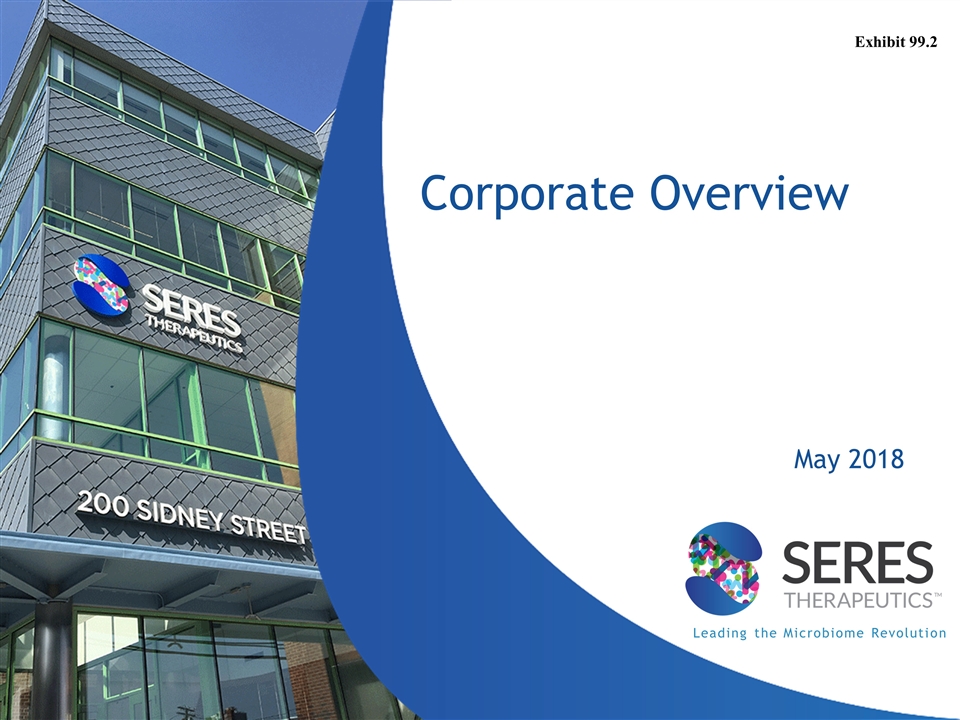
Corporate Overview May 2018 Exhibit 99.2
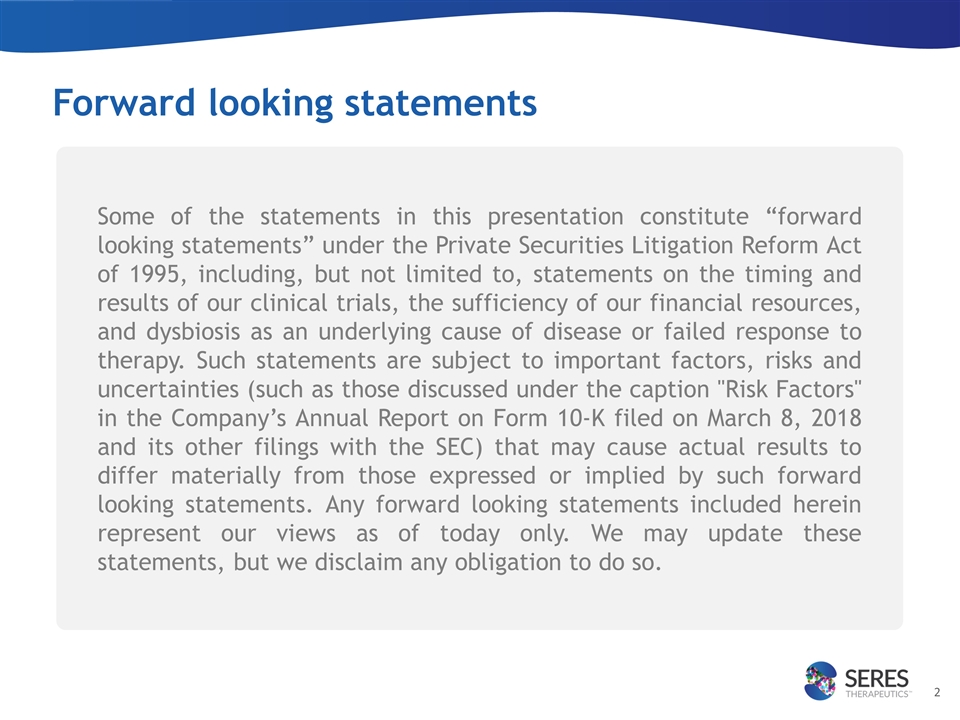
Some of the statements in this presentation constitute “forward looking statements” under the Private Securities Litigation Reform Act of 1995, including, but not limited to, statements on the timing and results of our clinical trials, the sufficiency of our financial resources, and dysbiosis as an underlying cause of disease or failed response to therapy. Such statements are subject to important factors, risks and uncertainties (such as those discussed under the caption "Risk Factors" in the Company’s Annual Report on Form 10-K filed on March 8, 2018 and its other filings with the SEC) that may cause actual results to differ materially from those expressed or implied by such forward looking statements. Any forward looking statements included herein represent our views as of today only. We may update these statements, but we disclaim any obligation to do so. Forward looking statements
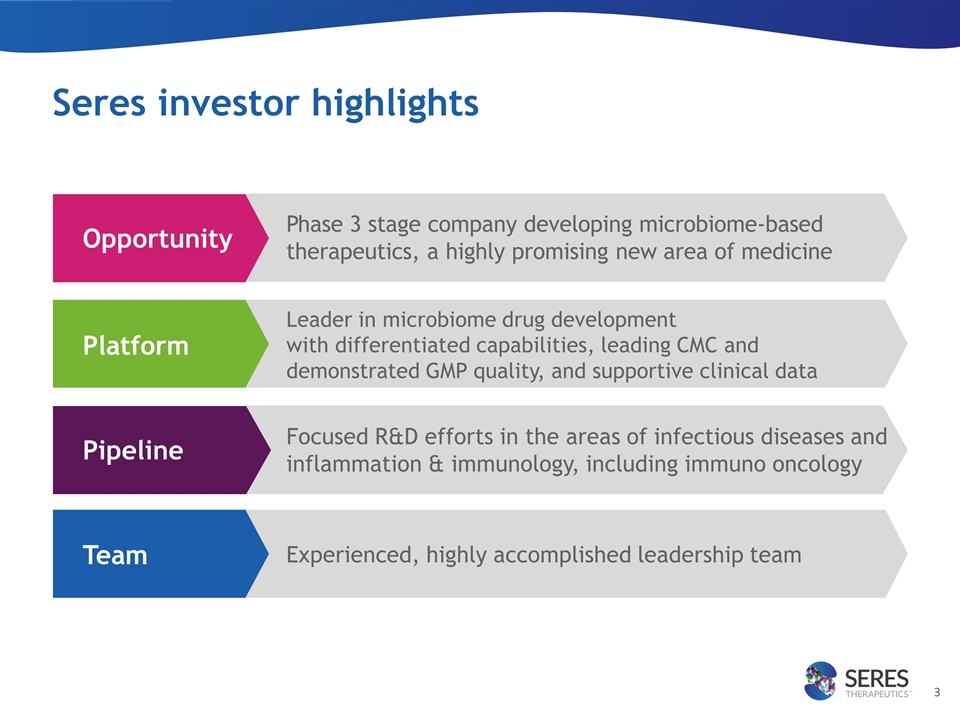
Seres investor highlights Phase 3 stage company developing microbiome-based therapeutics, a highly promising new area of medicine Leader in microbiome drug development with differentiated capabilities, leading CMC and demonstrated GMP quality, and supportive clinical data Focused R&D efforts in the areas of infectious diseases and inflammation & immunology, including immuno oncology Experienced, highly accomplished leadership team Platform Opportunity Pipeline Team
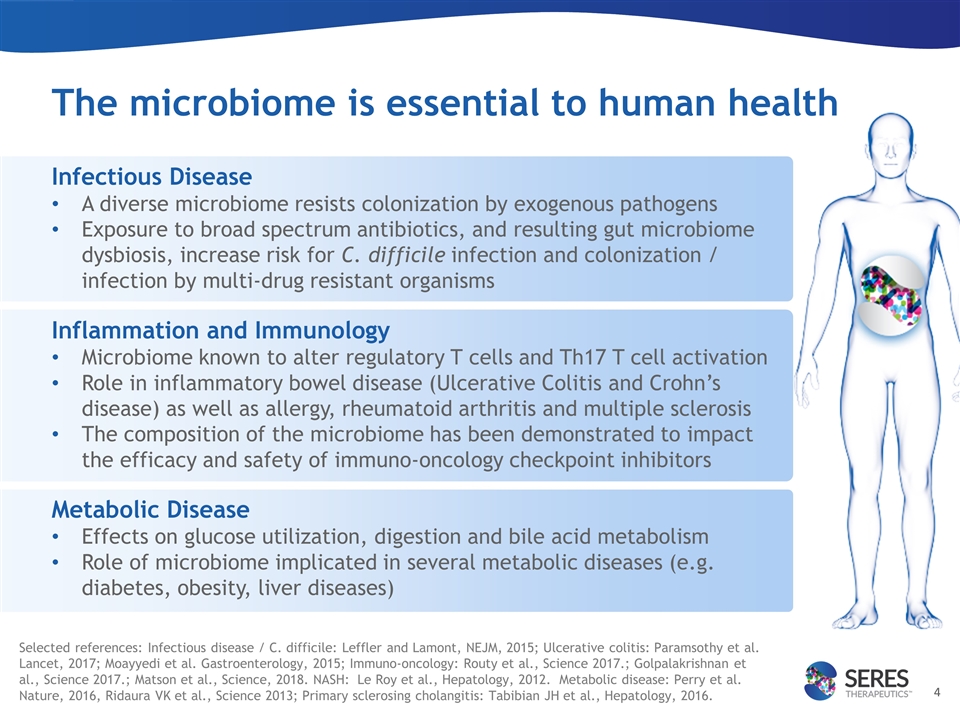
The microbiome is essential to human health Infectious Disease A diverse microbiome resists colonization by exogenous pathogens Exposure to broad spectrum antibiotics, and resulting gut microbiome dysbiosis, increase risk for C. difficile infection and colonization / infection by multi-drug resistant organisms Inflammation and Immunology Microbiome known to alter regulatory T cells and Th17 T cell activation Role in inflammatory bowel disease (Ulcerative Colitis and Crohn’s disease) as well as allergy, rheumatoid arthritis and multiple sclerosis The composition of the microbiome has been demonstrated to impact the efficacy and safety of immuno-oncology checkpoint inhibitors Metabolic Disease Effects on glucose utilization, digestion and bile acid metabolism Role of microbiome implicated in several metabolic diseases (e.g. diabetes, obesity, liver diseases) Selected references: Infectious disease / C. difficile: Leffler and Lamont, NEJM, 2015; Ulcerative colitis: Paramsothy et al. Lancet, 2017; Moayyedi et al. Gastroenterology, 2015; Immuno-oncology: Routy et al., Science 2017.; Golpalakrishnan et al., Science 2017.; Matson et al., Science, 2018. NASH: Le Roy et al., Hepatology, 2012. Metabolic disease: Perry et al. Nature, 2016, Ridaura VK et al., Science 2013; Primary sclerosing cholangitis: Tabibian JH et al., Hepatology, 2016.
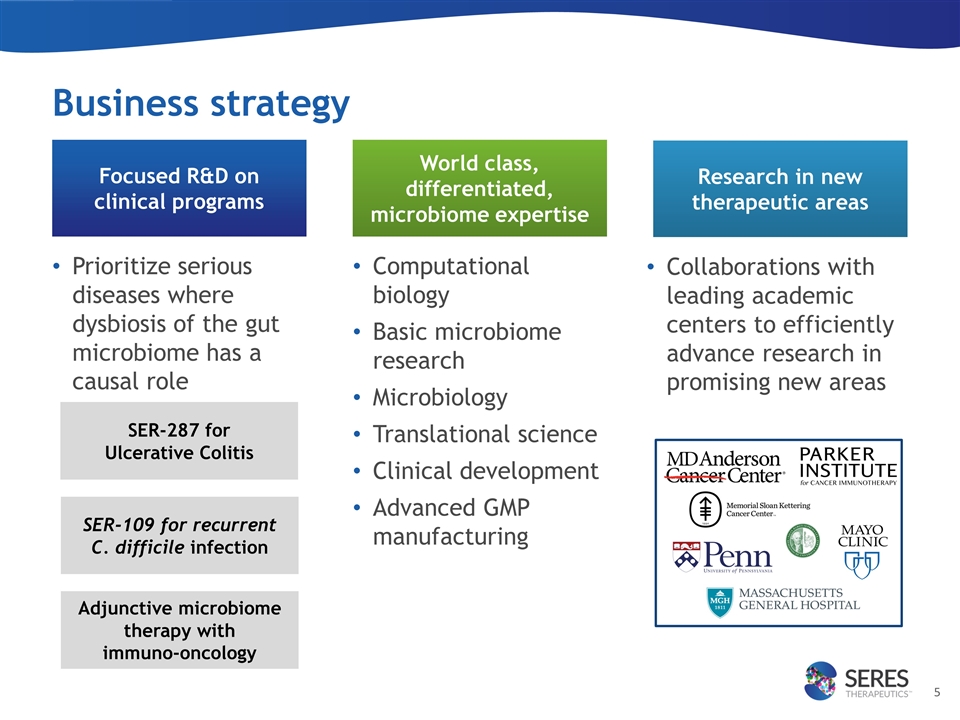
Business strategy Prioritize serious diseases where dysbiosis of the gut microbiome has a causal role Focused R&D on clinical programs Computational biology Basic microbiome research Microbiology Translational science Clinical development Advanced GMP manufacturing World class, differentiated, microbiome expertise Collaborations with leading academic centers to efficiently advance research in promising new areas Research in new therapeutic areas SER-287 for Ulcerative Colitis SER-109 for recurrent C. difficile infection Adjunctive microbiome therapy with immuno-oncology
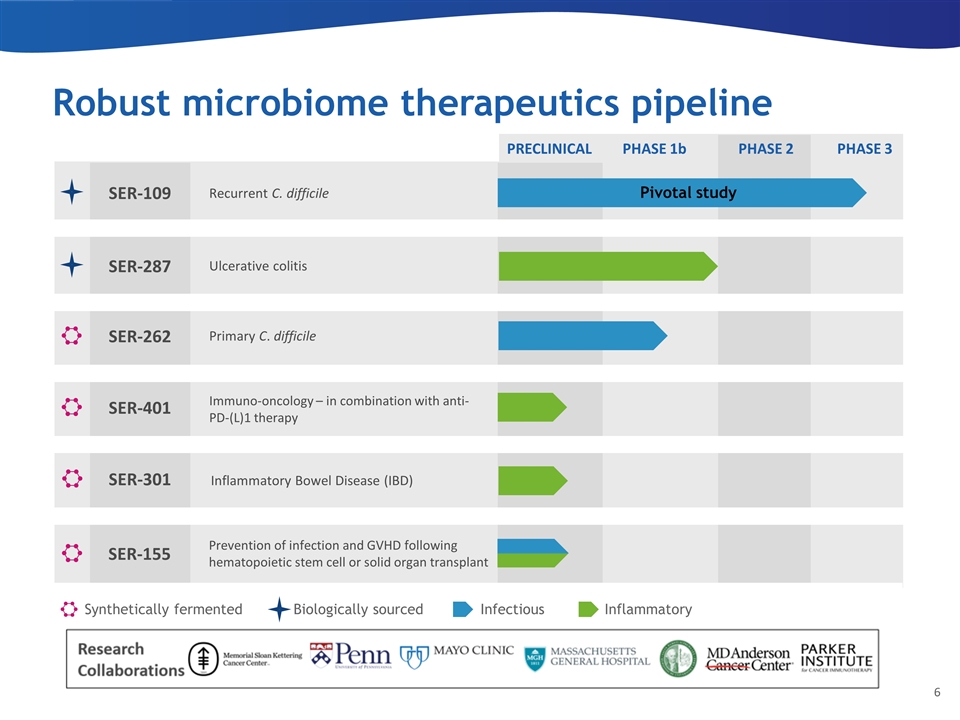
Robust microbiome therapeutics pipeline PRECLINICAL PHASE 1b PHASE 2 Synthetically fermented Infectious Inflammatory SER-401 Inflammatory Bowel Disease (IBD) SER-262 Primary C. difficile SER-301 Immuno-oncology – in combination with anti-PD-(L)1 therapy Biologically sourced SER-287 Ulcerative colitis PHASE 3 SER-109 Recurrent C. difficile SER-155 Prevention of infection and GVHD following hematopoietic stem cell or solid organ transplant Pivotal study
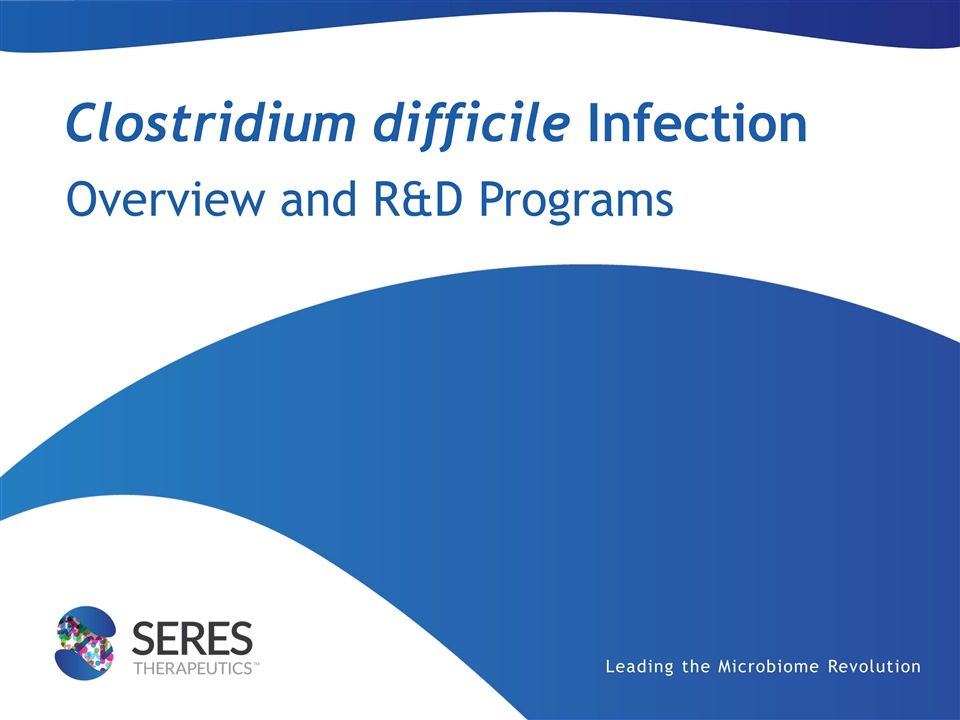
Clostridium difficile Infection Overview and R&D Programs
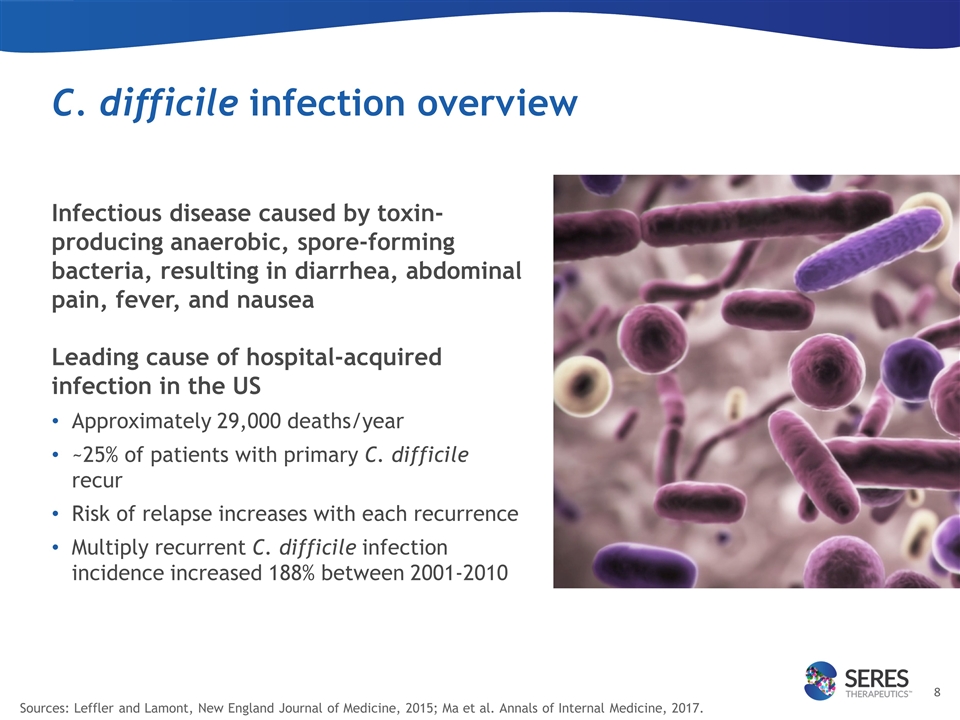
C. difficile infection overview Infectious disease caused by toxin-producing anaerobic, spore-forming bacteria, resulting in diarrhea, abdominal pain, fever, and nausea Leading cause of hospital-acquired infection in the US Approximately 29,000 deaths/year ~25% of patients with primary C. difficile recur Risk of relapse increases with each recurrence Multiply recurrent C. difficile infection incidence increased 188% between 2001-2010 Sources: Leffler and Lamont, New England Journal of Medicine, 2015; Ma et al. Annals of Internal Medicine, 2017.
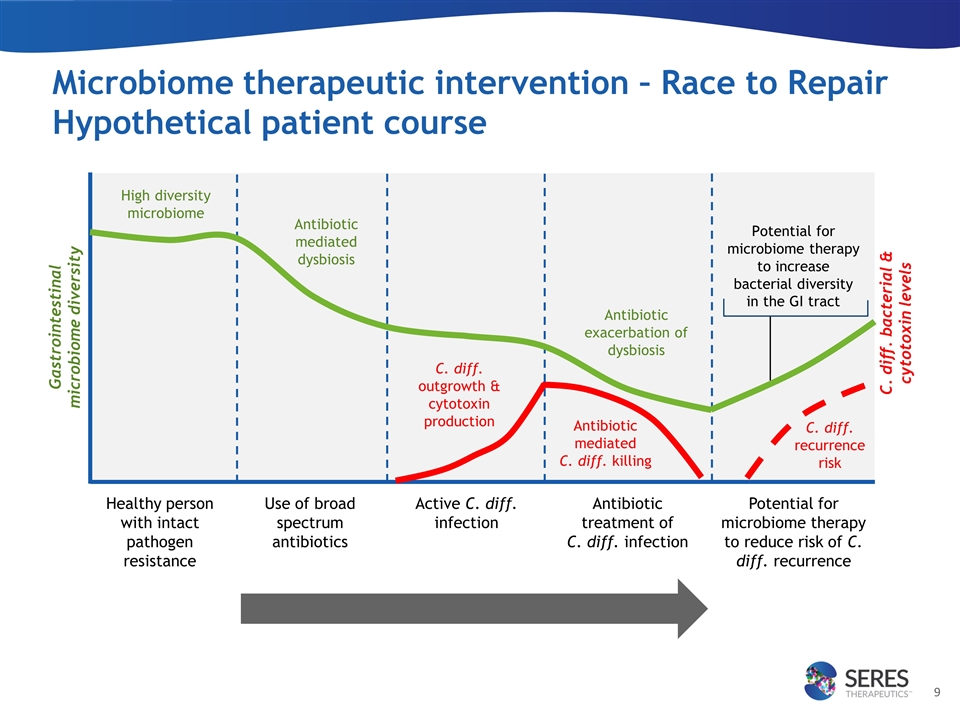
Microbiome therapeutic intervention – Race to Repair Hypothetical patient course Healthy person with intact pathogen resistance High diversity microbiome Use of broad spectrum antibiotics Active C. diff. infection Antibiotic treatment of C. diff. infection Potential for microbiome therapy to reduce risk of C. diff. recurrence Antibiotic mediated C. diff. killing Antibiotic exacerbation of dysbiosis Gastrointestinal microbiome diversity C. diff. bacterial & cytotoxin levels C. diff. recurrence risk C. diff. outgrowth & cytotoxin production Potential for microbiome therapy to increase bacterial diversity in the GI tract Antibiotic mediated dysbiosis
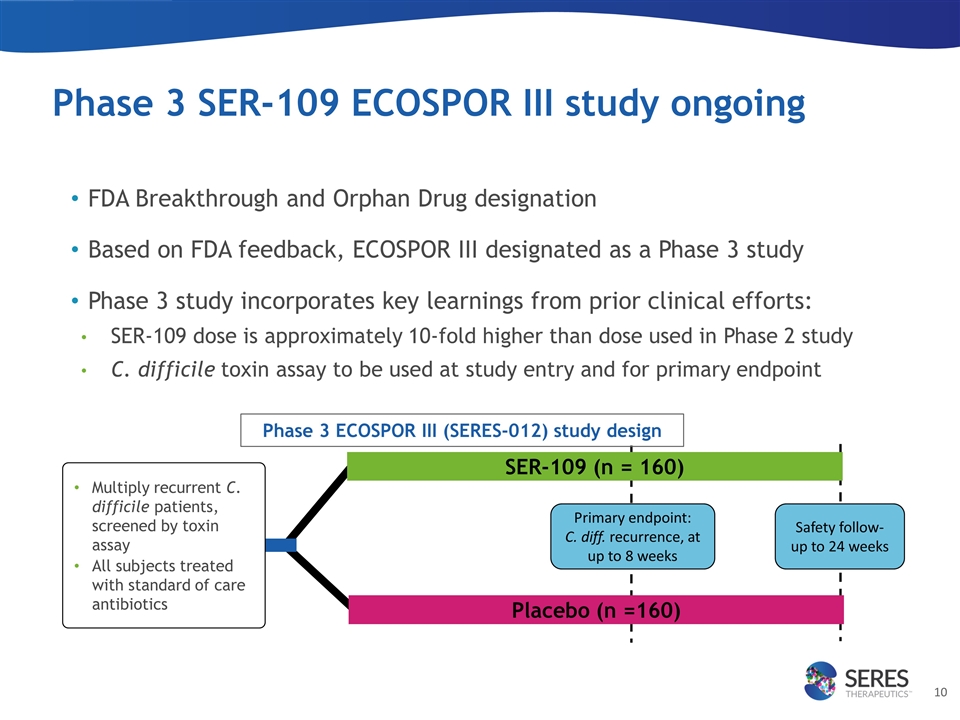
Phase 3 SER-109 ECOSPOR III study ongoing FDA Breakthrough and Orphan Drug designation Based on FDA feedback, ECOSPOR III designated as a Phase 3 study Phase 3 study incorporates key learnings from prior clinical efforts: SER-109 dose is approximately 10-fold higher than dose used in Phase 2 study C. difficile toxin assay to be used at study entry and for primary endpoint Multiply recurrent C. difficile patients, screened by toxin assay All subjects treated with standard of care antibiotics Primary endpoint: C. diff. recurrence, at up to 8 weeks Safety follow-up to 24 weeks Phase 3 ECOSPOR III (SERES-012) study design SER-109 (n = 160) Placebo (n =160)
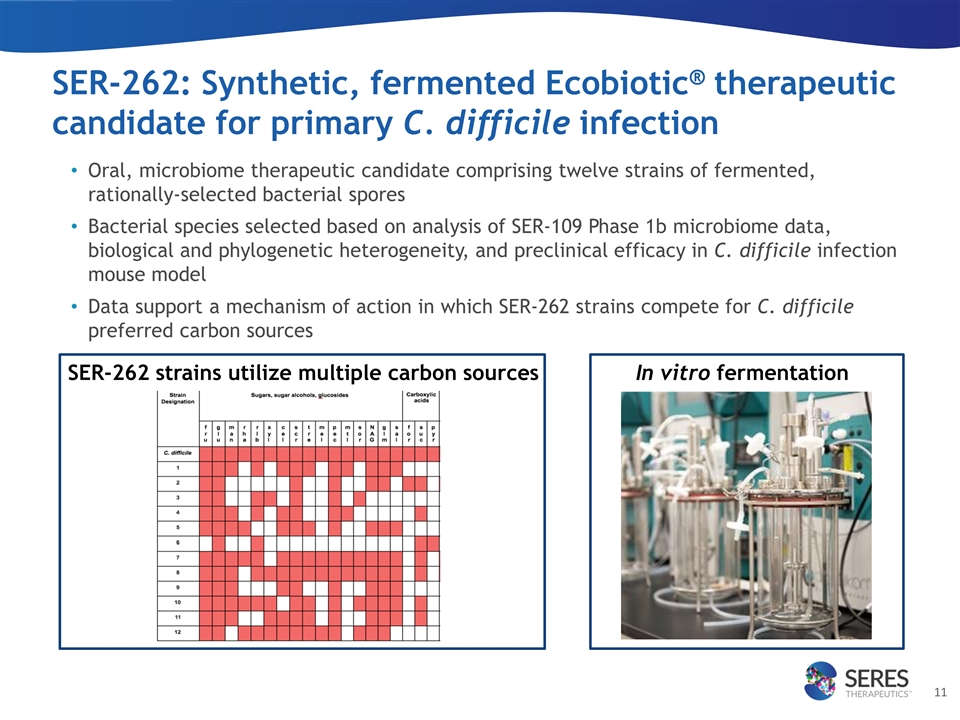
SER-262: Synthetic, fermented Ecobiotic® therapeutic candidate for primary C. difficile infection Oral, microbiome therapeutic candidate comprising twelve strains of fermented, rationally-selected bacterial spores Bacterial species selected based on analysis of SER-109 Phase 1b microbiome data, biological and phylogenetic heterogeneity, and preclinical efficacy in C. difficile infection mouse model Data support a mechanism of action in which SER-262 strains compete for C. difficile preferred carbon sources SER-262 strains utilize multiple carbon sources In vitro fermentation
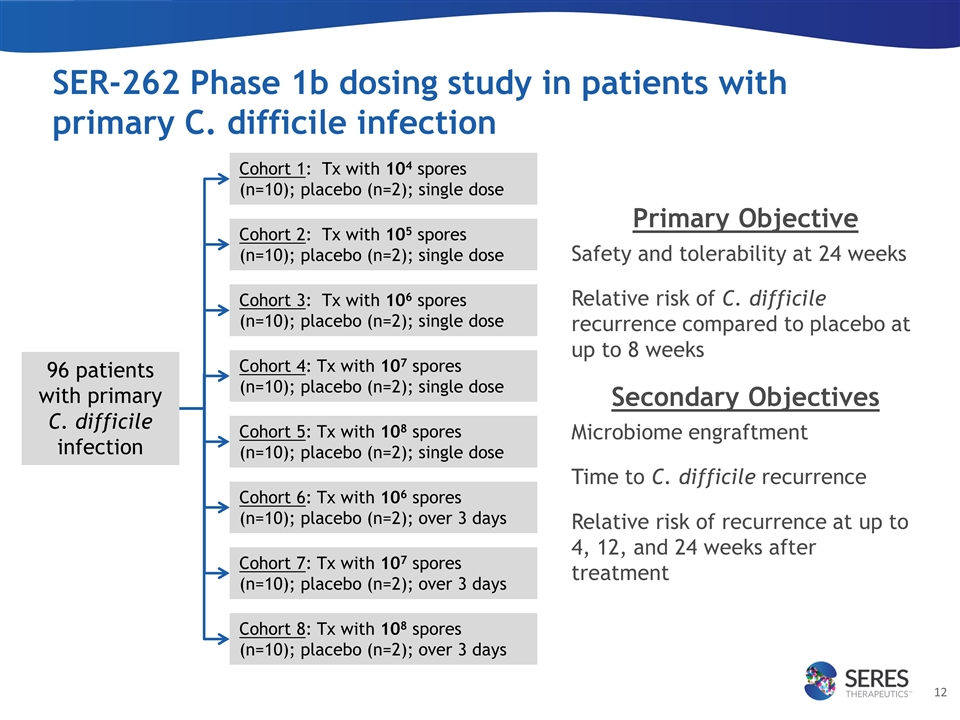
SER-262 Phase 1b dosing study in patients with primary C. difficile infection Primary Objective Safety and tolerability at 24 weeks Relative risk of C. difficile recurrence compared to placebo at up to 8 weeks Secondary Objectives Microbiome engraftment Time to C. difficile recurrence Relative risk of recurrence at up to 4, 12, and 24 weeks after treatment Cohort 1: Tx with 104 spores (n=10); placebo (n=2); single dose Cohort 2: Tx with 105 spores (n=10); placebo (n=2); single dose Cohort 3: Tx with 106 spores (n=10); placebo (n=2); single dose Cohort 4: Tx with 107 spores (n=10); placebo (n=2); single dose 96 patients with primary C. difficile infection Cohort 5: Tx with 108 spores (n=10); placebo (n=2); single dose Cohort 6: Tx with 106 spores (n=10); placebo (n=2); over 3 days Cohort 7: Tx with 107 spores (n=10); placebo (n=2); over 3 days Cohort 8: Tx with 108 spores (n=10); placebo (n=2); over 3 days
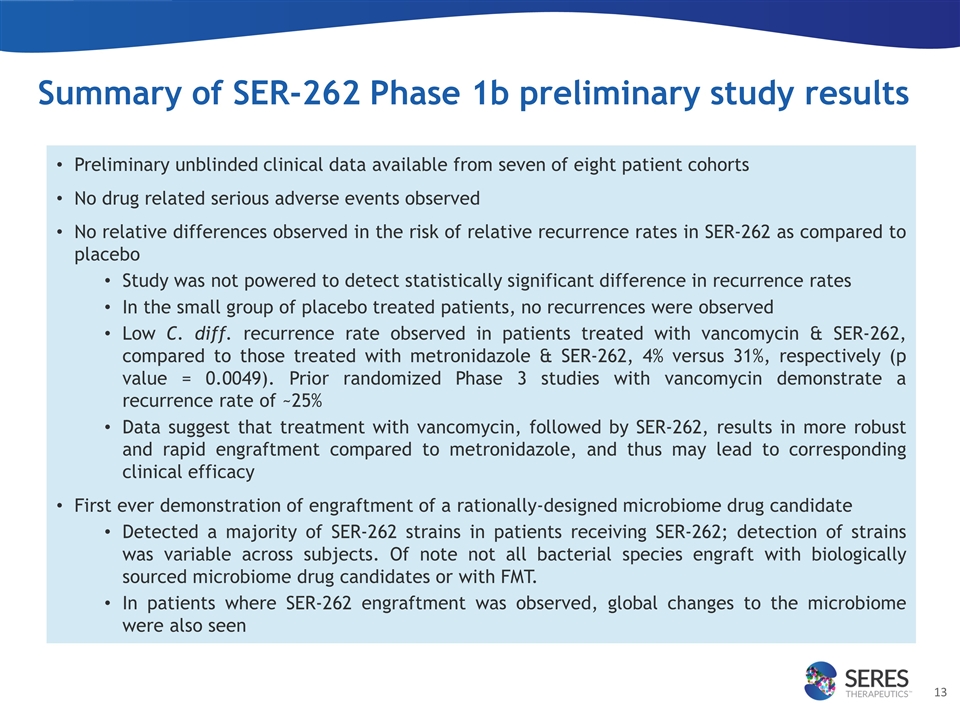
Summary of SER-262 Phase 1b preliminary study results Preliminary unblinded clinical data available from seven of eight patient cohorts No drug related serious adverse events observed No relative differences observed in the risk of relative recurrence rates in SER-262 as compared to placebo Study was not powered to detect statistically significant difference in recurrence rates In the small group of placebo treated patients, no recurrences were observed Low C. diff. recurrence rate observed in patients treated with vancomycin & SER-262, compared to those treated with metronidazole & SER-262, 4% versus 31%, respectively (p value = 0.0049). Prior randomized Phase 3 studies with vancomycin demonstrate a recurrence rate of ~25% Data suggest that treatment with vancomycin, followed by SER-262, results in more robust and rapid engraftment compared to metronidazole, and thus may lead to corresponding clinical efficacy First ever demonstration of engraftment of a rationally-designed microbiome drug candidate Detected a majority of SER-262 strains in patients receiving SER-262; detection of strains was variable across subjects. Of note not all bacterial species engraft with biologically sourced microbiome drug candidates or with FMT. In patients where SER-262 engraftment was observed, global changes to the microbiome were also seen
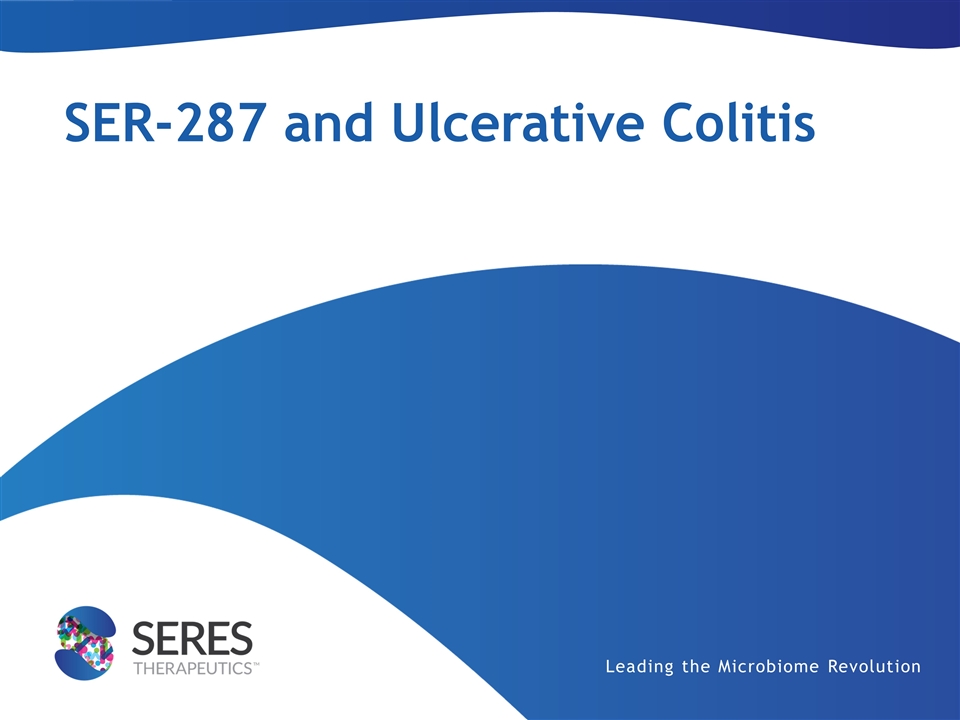
SER-287 and Ulcerative Colitis
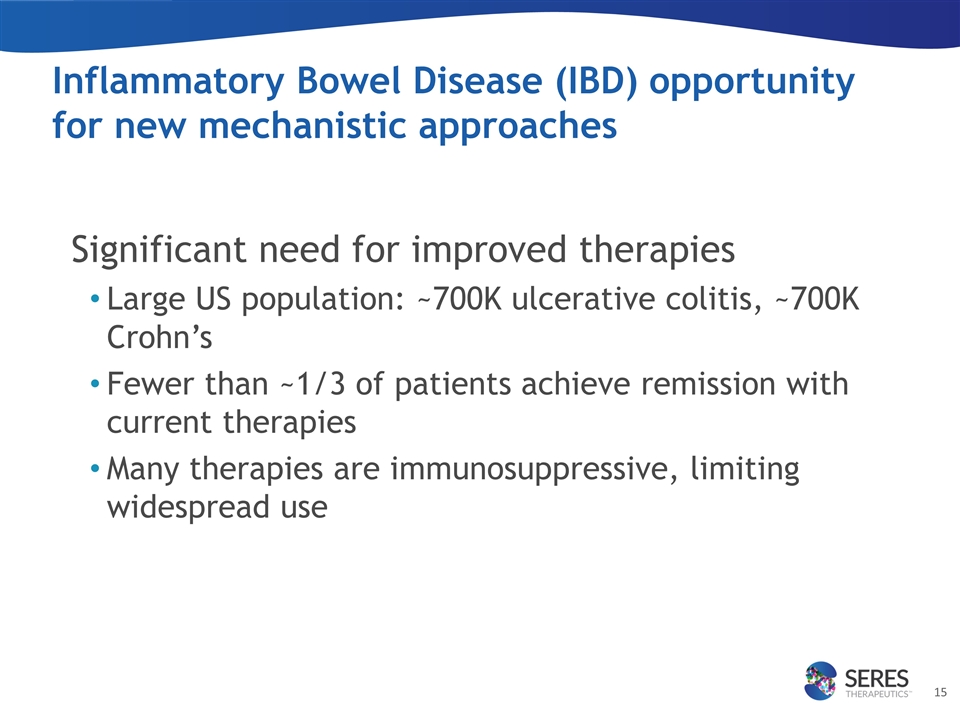
Inflammatory Bowel Disease (IBD) opportunity for new mechanistic approaches Significant need for improved therapies Large US population: ~700K ulcerative colitis, ~700K Crohn’s Fewer than ~1/3 of patients achieve remission with current therapies Many therapies are immunosuppressive, limiting widespread use
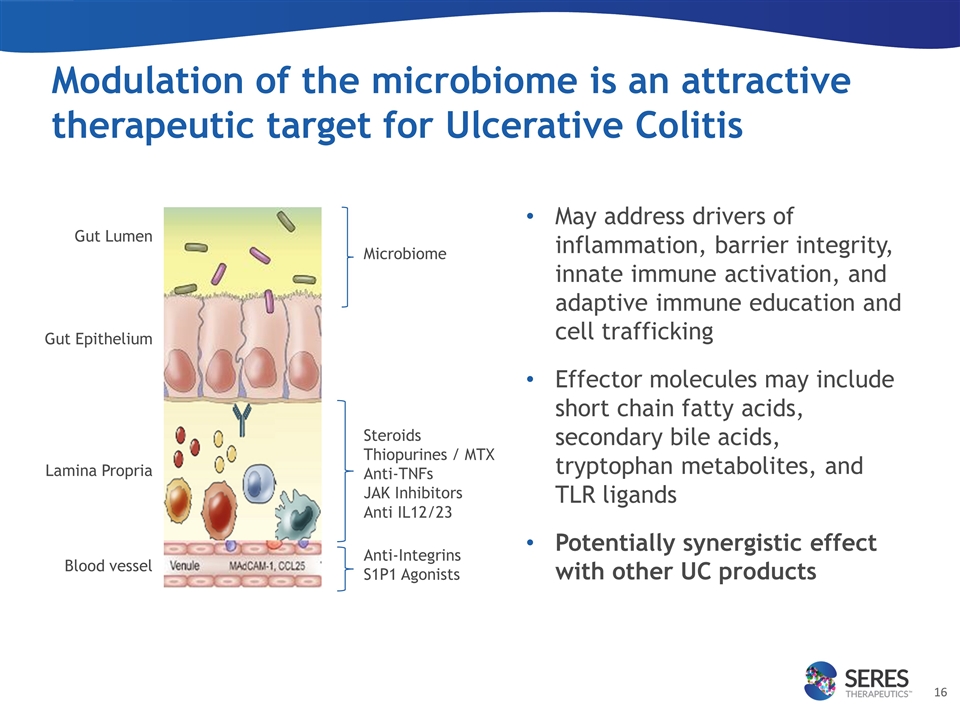
Modulation of the microbiome is an attractive therapeutic target for Ulcerative Colitis May address drivers of inflammation, barrier integrity, innate immune activation, and adaptive immune education and cell trafficking Effector molecules may include short chain fatty acids, secondary bile acids, tryptophan metabolites, and TLR ligands Potentially synergistic effect with other UC products Steroids Thiopurines / MTX Anti-TNFs JAK Inhibitors Anti IL12/23 Microbiome Anti-Integrins S1P1 Agonists Gut Lumen Lamina Propria Blood vessel Gut Epithelium
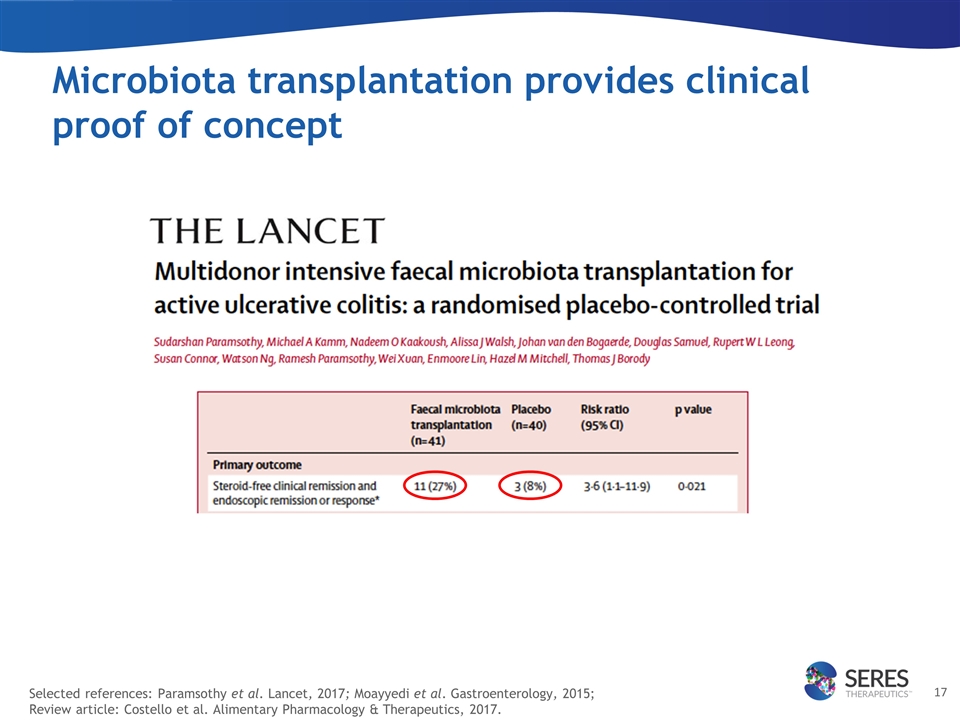
Selected references: Paramsothy et al. Lancet, 2017; Moayyedi et al. Gastroenterology, 2015; Review article: Costello et al. Alimentary Pharmacology & Therapeutics, 2017. Microbiota transplantation provides clinical proof of concept
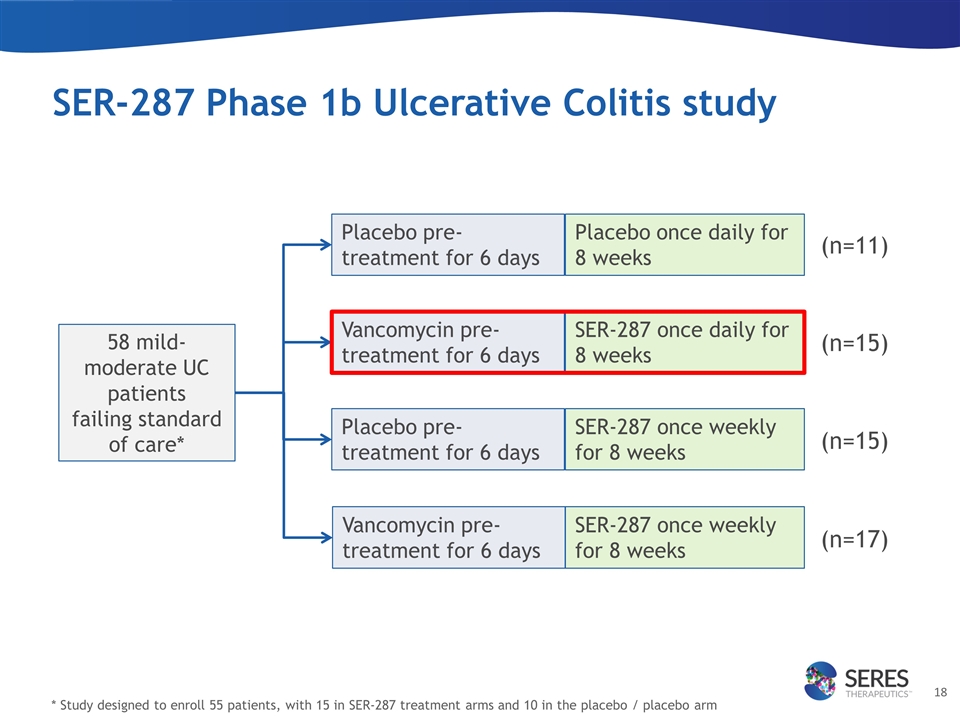
SER-287 Phase 1b Ulcerative Colitis study 58 mild-moderate UC patients failing standard of care* * Study designed to enroll 55 patients, with 15 in SER-287 treatment arms and 10 in the placebo / placebo arm Placebo pre-treatment for 6 days Placebo pre-treatment for 6 days Vancomycin pre-treatment for 6 days Vancomycin pre-treatment for 6 days SER-287 once weekly for 8 weeks Placebo once daily for 8 weeks SER-287 once daily for 8 weeks SER-287 once weekly for 8 weeks (n=11) (n=15) (n=15) (n=17)
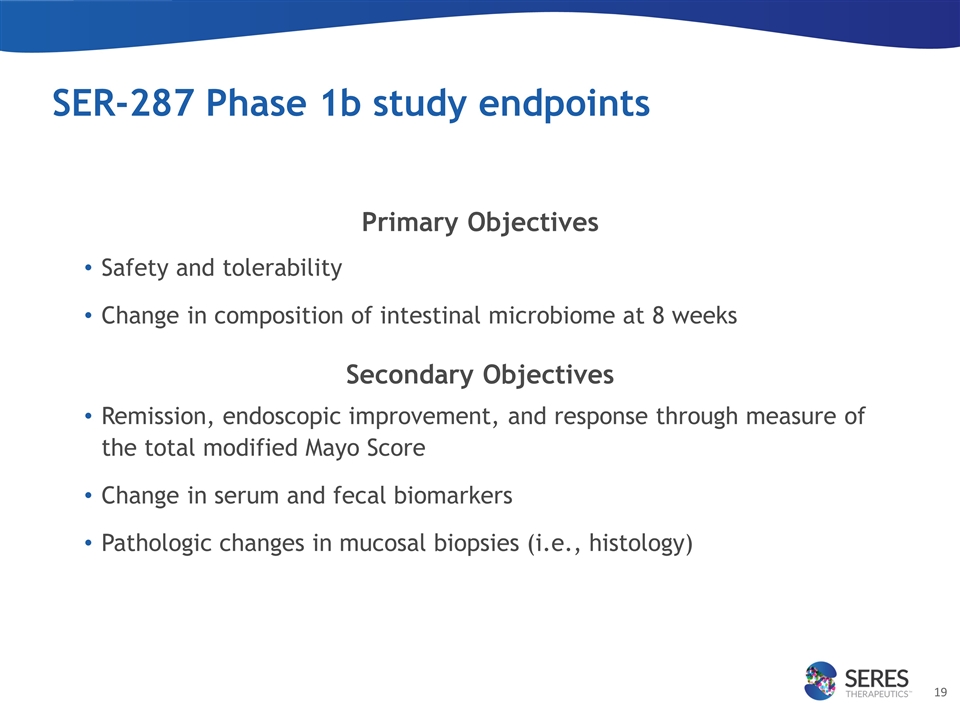
SER-287 Phase 1b study endpoints Primary Objectives Safety and tolerability Change in composition of intestinal microbiome at 8 weeks Secondary Objectives Remission, endoscopic improvement, and response through measure of the total modified Mayo Score Change in serum and fecal biomarkers Pathologic changes in mucosal biopsies (i.e., histology)
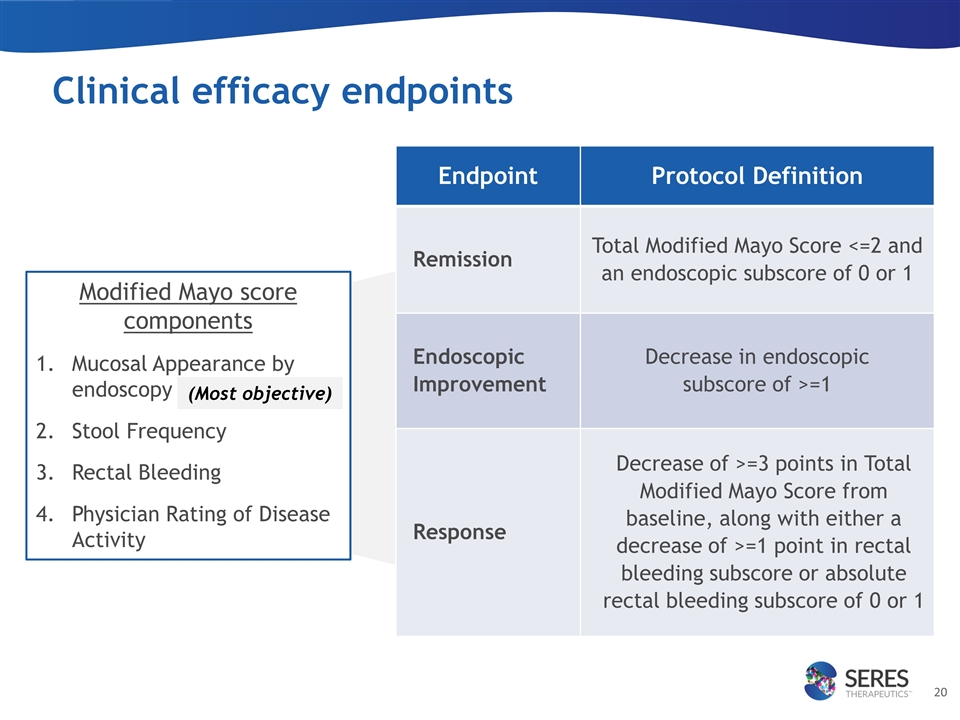
Clinical efficacy endpoints Endpoint Protocol Definition Remission Total Modified Mayo Score <=2 and an endoscopic subscore of 0 or 1 Endoscopic Improvement Decrease in endoscopic subscore of >=1 Response Decrease of >=3 points in Total Modified Mayo Score from baseline, along with either a decrease of >=1 point in rectal bleeding subscore or absolute rectal bleeding subscore of 0 or 1 Modified Mayo score components Mucosal Appearance by endoscopy Stool Frequency Rectal Bleeding Physician Rating of Disease Activity (Most objective)
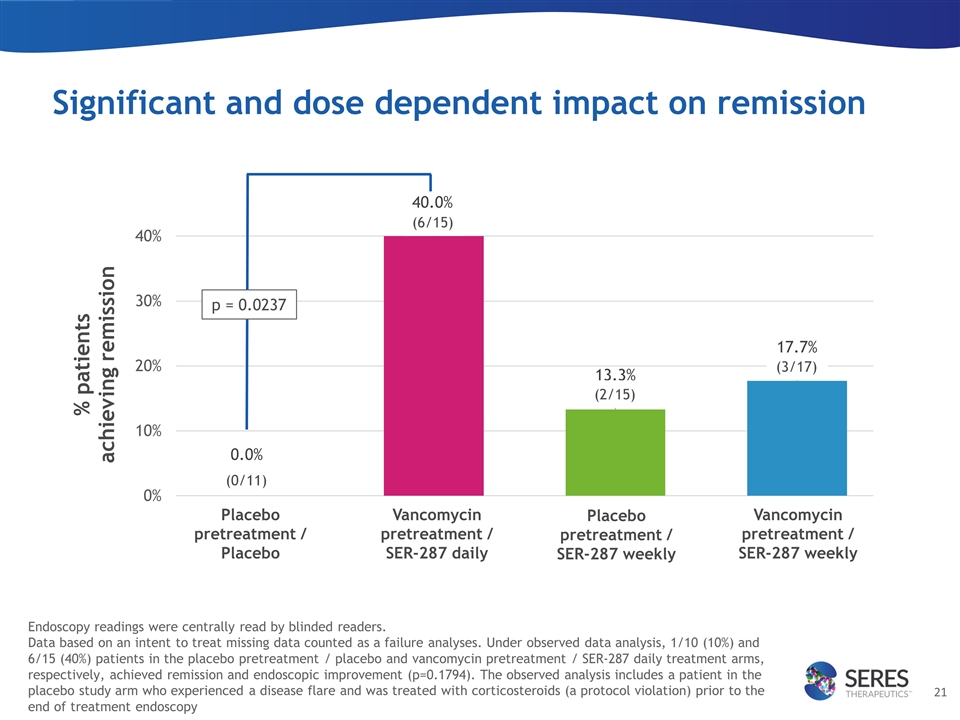
Significant and dose dependent impact on remission Placebo pretreatment / Placebo Vancomycin pretreatment / SER-287 daily Placebo pretreatment / SER-287 weekly Vancomycin pretreatment / SER-287 weekly p = 0.0237 (0/11) (6/15) (2/15) (3/17) Endoscopy readings were centrally read by blinded readers. Data based on an intent to treat missing data counted as a failure analyses. Under observed data analysis, 1/10 (10%) and 6/15 (40%) patients in the placebo pretreatment / placebo and vancomycin pretreatment / SER-287 daily treatment arms, respectively, achieved remission and endoscopic improvement (p=0.1794). The observed analysis includes a patient in the placebo study arm who experienced a disease flare and was treated with corticosteroids (a protocol violation) prior to the end of treatment endoscopy
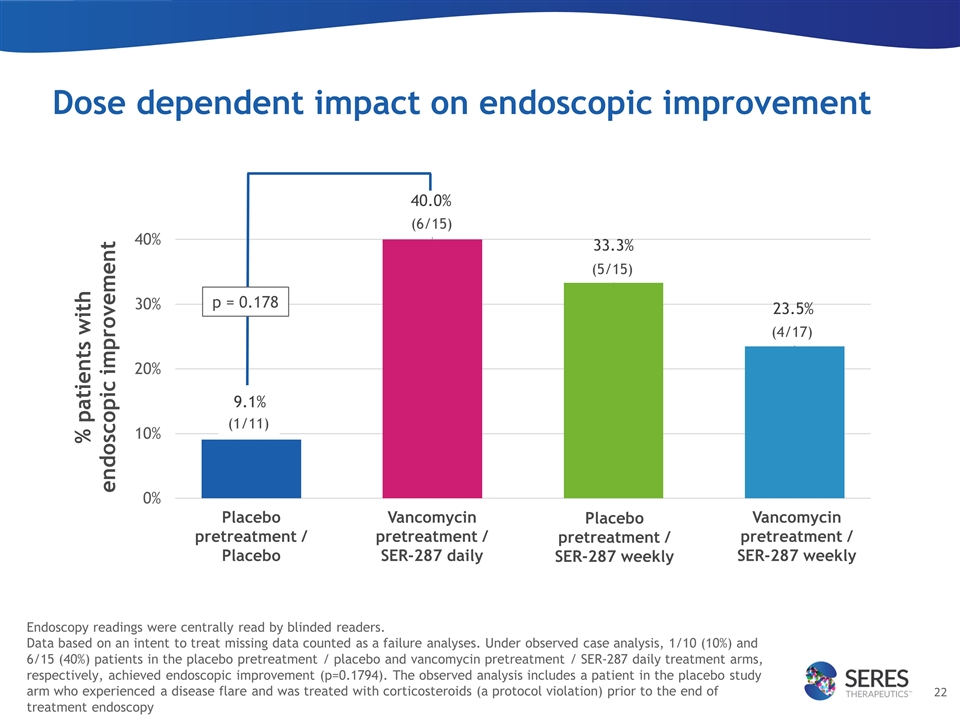
Dose dependent impact on endoscopic improvement Placebo pretreatment / Placebo Vancomycin pretreatment / SER-287 daily Placebo pretreatment / SER-287 weekly Vancomycin pretreatment / SER-287 weekly p = 0.178 (1/11) (6/15) (5/15) (4/17) Endoscopy readings were centrally read by blinded readers. Data based on an intent to treat missing data counted as a failure analyses. Under observed case analysis, 1/10 (10%) and 6/15 (40%) patients in the placebo pretreatment / placebo and vancomycin pretreatment / SER-287 daily treatment arms, respectively, achieved endoscopic improvement (p=0.1794). The observed analysis includes a patient in the placebo study arm who experienced a disease flare and was treated with corticosteroids (a protocol violation) prior to the end of treatment endoscopy
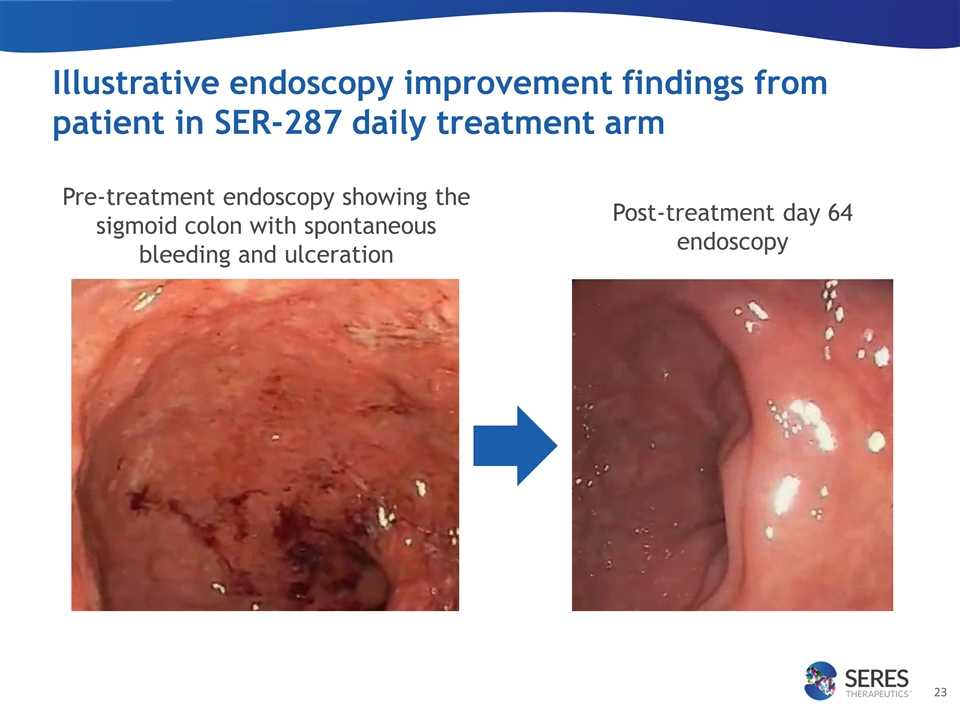
Pre-treatment endoscopy showing the sigmoid colon with spontaneous bleeding and ulceration Post-treatment day 64 endoscopy Illustrative endoscopy improvement findings from patient in SER-287 daily treatment arm
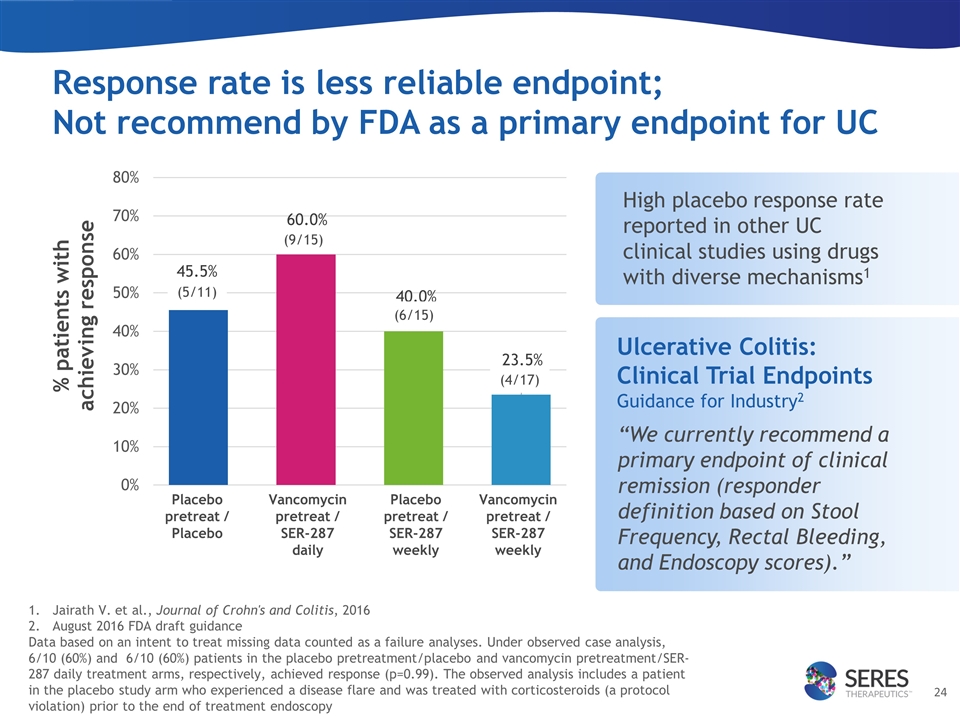
Response rate is less reliable endpoint; Not recommend by FDA as a primary endpoint for UC Placebo pretreat / Placebo Vancomycin pretreat / SER-287 daily Placebo pretreat / SER-287 weekly Vancomycin pretreat / SER-287 weekly Ulcerative Colitis: Clinical Trial Endpoints Guidance for Industry2 (5/11) (9/15) (6/15) (4/17) Jairath V. et al., Journal of Crohn's and Colitis, 2016 August 2016 FDA draft guidance Data based on an intent to treat missing data counted as a failure analyses. Under observed case analysis, 6/10 (60%) and 6/10 (60%) patients in the placebo pretreatment/placebo and vancomycin pretreatment/SER-287 daily treatment arms, respectively, achieved response (p=0.99). The observed analysis includes a patient in the placebo study arm who experienced a disease flare and was treated with corticosteroids (a protocol violation) prior to the end of treatment endoscopy “We currently recommend a primary endpoint of clinical remission (responder definition based on Stool Frequency, Rectal Bleeding, and Endoscopy scores).” High placebo response rate reported in other UC clinical studies using drugs with diverse mechanisms1
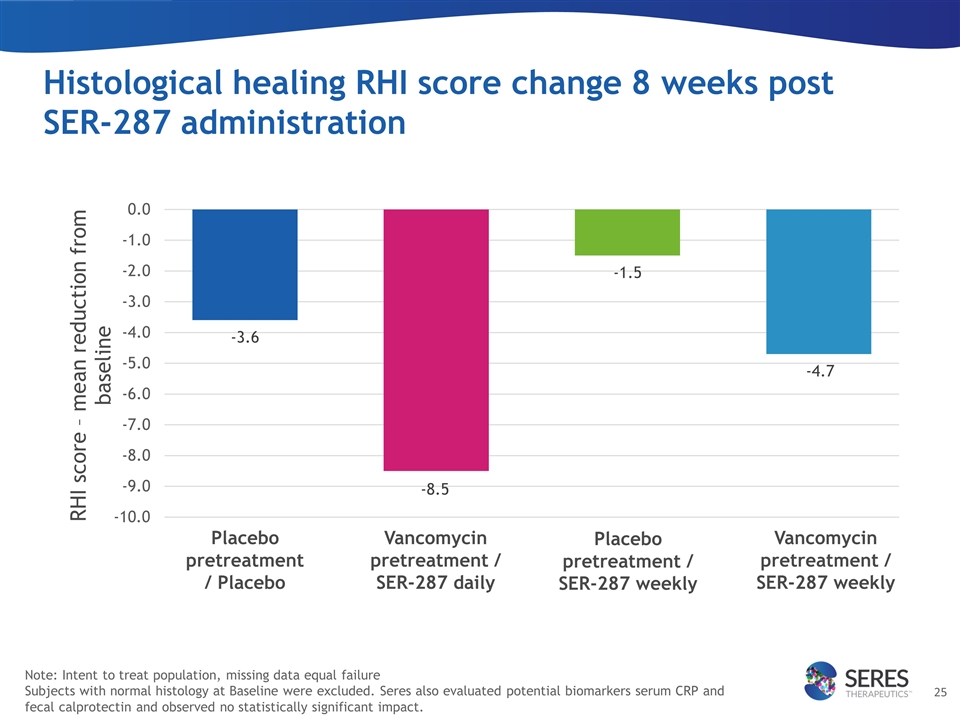
Histological healing RHI score change 8 weeks post SER-287 administration Placebo pretreatment / Placebo Vancomycin pretreatment / SER-287 daily Placebo pretreatment / SER-287 weekly Vancomycin pretreatment / SER-287 weekly Note: Intent to treat population, missing data equal failure Subjects with normal histology at Baseline were excluded. Seres also evaluated potential biomarkers serum CRP and fecal calprotectin and observed no statistically significant impact.
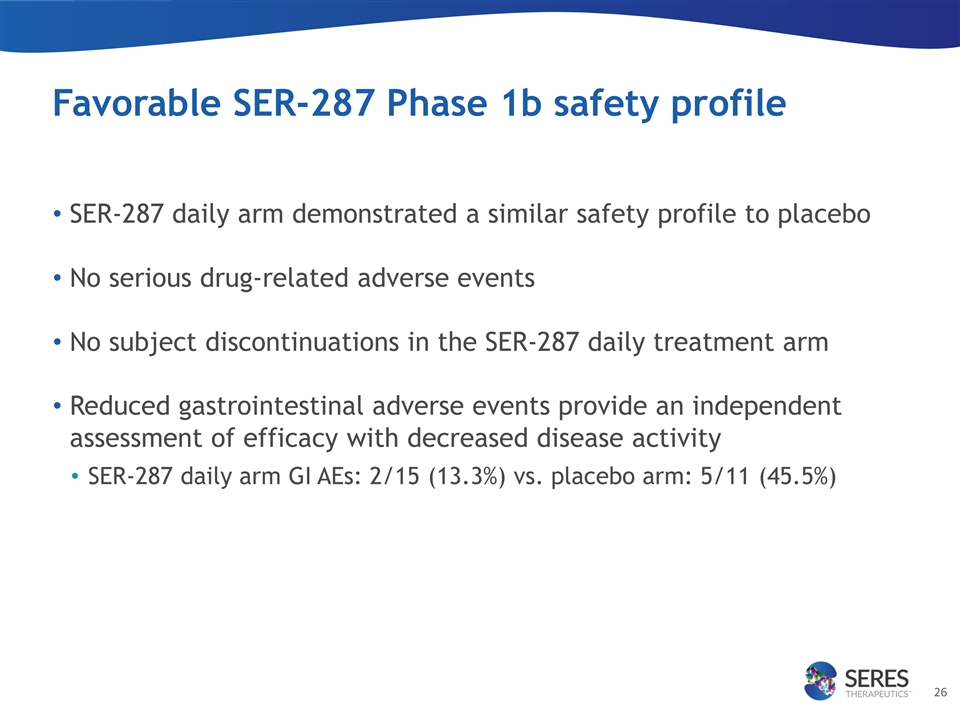
Favorable SER-287 Phase 1b safety profile SER-287 daily arm demonstrated a similar safety profile to placebo No serious drug-related adverse events No subject discontinuations in the SER-287 daily treatment arm Reduced gastrointestinal adverse events provide an independent assessment of efficacy with decreased disease activity SER-287 daily arm GI AEs: 2/15 (13.3%) vs. placebo arm: 5/11 (45.5%)
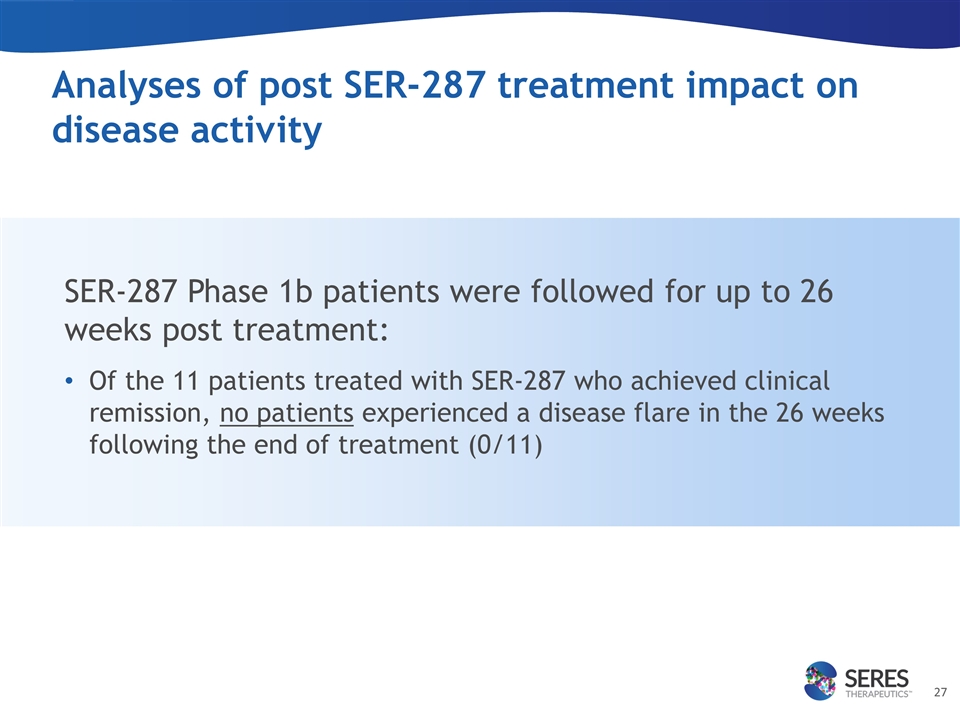
Analyses of post SER-287 treatment impact on disease activity SER-287 Phase 1b patients were followed for up to 26 weeks post treatment: Of the 11 patients treated with SER-287 who achieved clinical remission, no patients experienced a disease flare in the 26 weeks following the end of treatment (0/11)
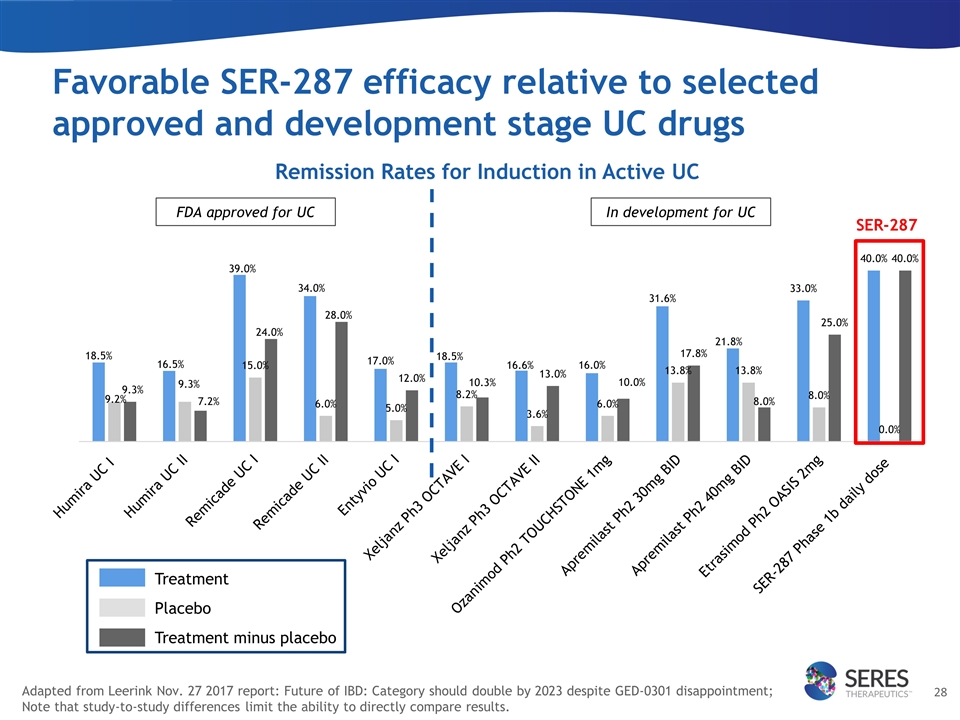
Adapted from Leerink Nov. 27 2017 report: Future of IBD: Category should double by 2023 despite GED-0301 disappointment; Note that study-to-study differences limit the ability to directly compare results. Remission Rates for Induction in Active UC SER-287 FDA approved for UC In development for UC Treatment Placebo Treatment minus placebo Favorable SER-287 efficacy relative to selected approved and development stage UC drugs
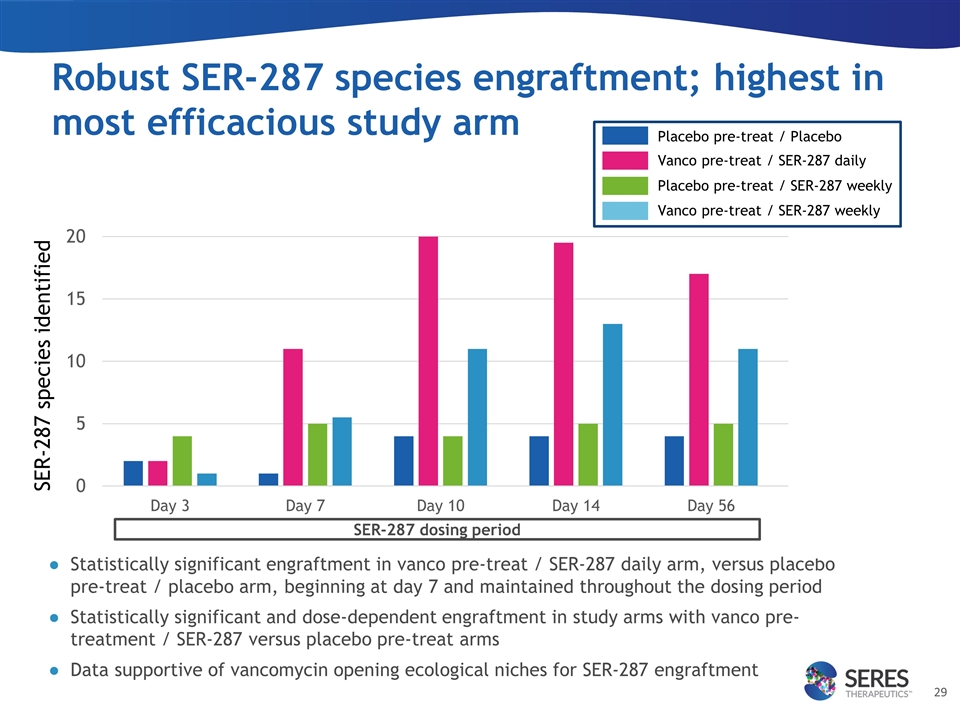
Robust SER-287 species engraftment; highest in most efficacious study arm Statistically significant engraftment in vanco pre-treat / SER-287 daily arm, versus placebo pre-treat / placebo arm, beginning at day 7 and maintained throughout the dosing period Statistically significant and dose-dependent engraftment in study arms with vanco pre-treatment / SER-287 versus placebo pre-treat arms Data supportive of vancomycin opening ecological niches for SER-287 engraftment SER-287 species identified SER-287 dosing period Placebo pre-treat / Placebo Vanco pre-treat / SER-287 daily Placebo pre-treat / SER-287 weekly Vanco pre-treat / SER-287 weekly
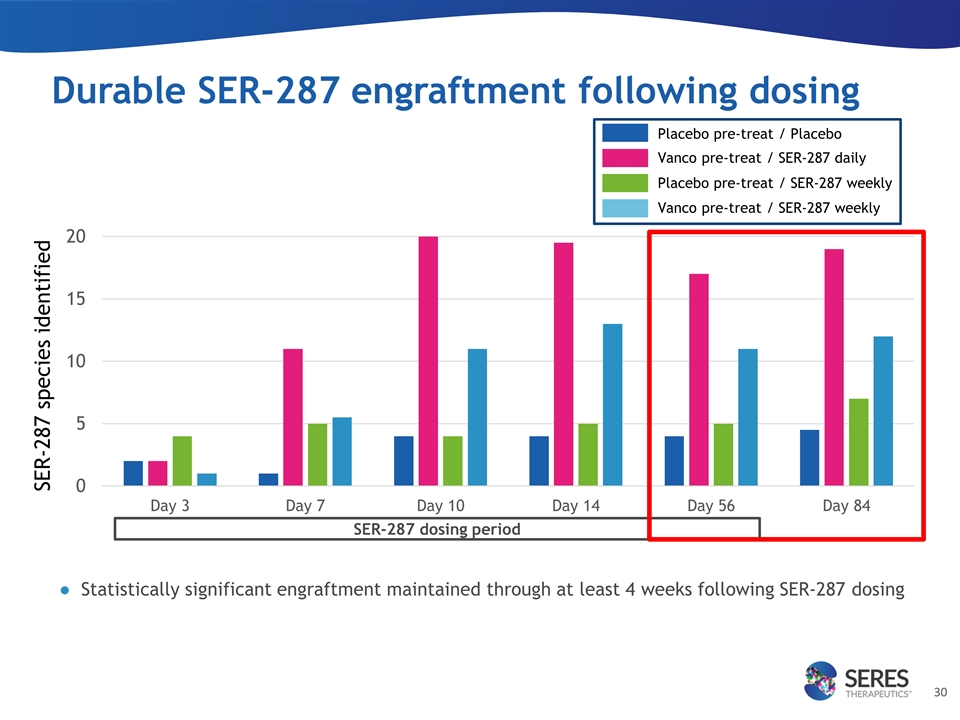
Durable SER-287 engraftment following dosing SER-287 species identified SER-287 dosing period Placebo pre-treat / Placebo Vanco pre-treat / SER-287 daily Placebo pre-treat / SER-287 weekly Vanco pre-treat / SER-287 weekly Statistically significant engraftment maintained through at least 4 weeks following SER-287 dosing

Specific bacterial species linked with remission Remission 7 days 10 days 14 days 56 days 84 days Non-remission 7 days 10 days 14 days 56 days 84 days Identified 27 species ecology statistically significantly correlated with remission Species include both SER-287 bacteria and others augmented by treatment Species more prevalent and abundant in patients achieving remission Species more prevalent and abundant in patients not achieving remission Relative abundance heatmap depiction of bacterial species prevalence from vanco pre-treat / SER-287 daily study arm patients. Each row represents a single bacterial species and each column represents a single patient. Shading of each square illustrates the relative abundance of each species. Less Relative species abundance More
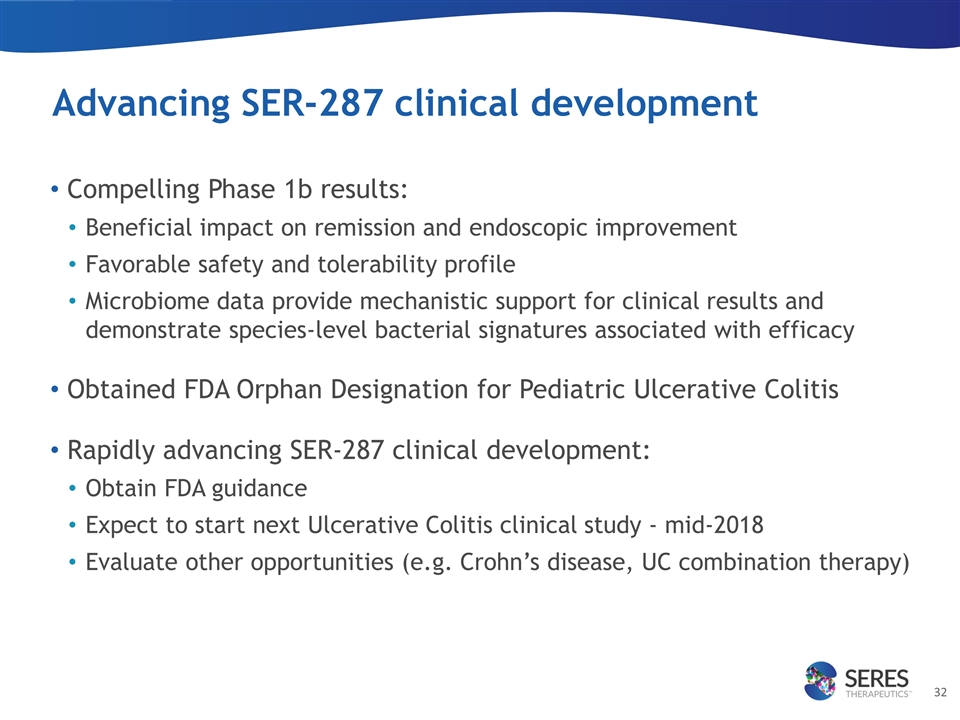
Advancing SER-287 clinical development Compelling Phase 1b results: Beneficial impact on remission and endoscopic improvement Favorable safety and tolerability profile Microbiome data provide mechanistic support for clinical results and demonstrate species-level bacterial signatures associated with efficacy Obtained FDA Orphan Designation for Pediatric Ulcerative Colitis Rapidly advancing SER-287 clinical development: Obtain FDA guidance Expect to start next Ulcerative Colitis clinical study - mid-2018 Evaluate other opportunities (e.g. Crohn’s disease, UC combination therapy)
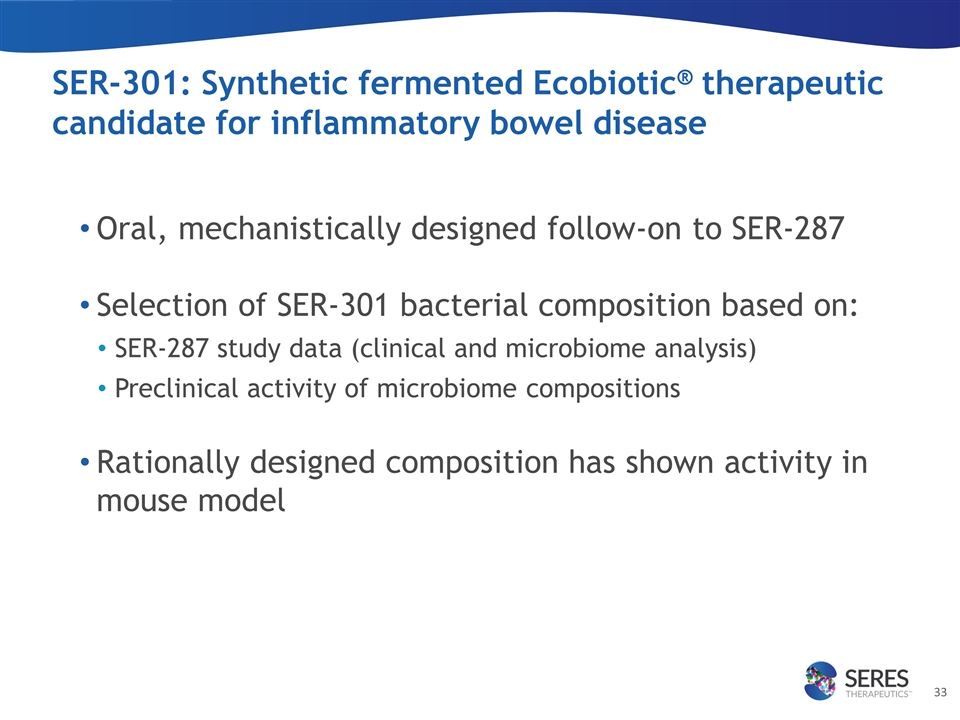
SER-301: Synthetic fermented Ecobiotic® therapeutic candidate for inflammatory bowel disease Oral, mechanistically designed follow-on to SER-287 Selection of SER-301 bacterial composition based on: SER-287 study data (clinical and microbiome analysis) Preclinical activity of microbiome compositions Rationally designed composition has shown activity in mouse model
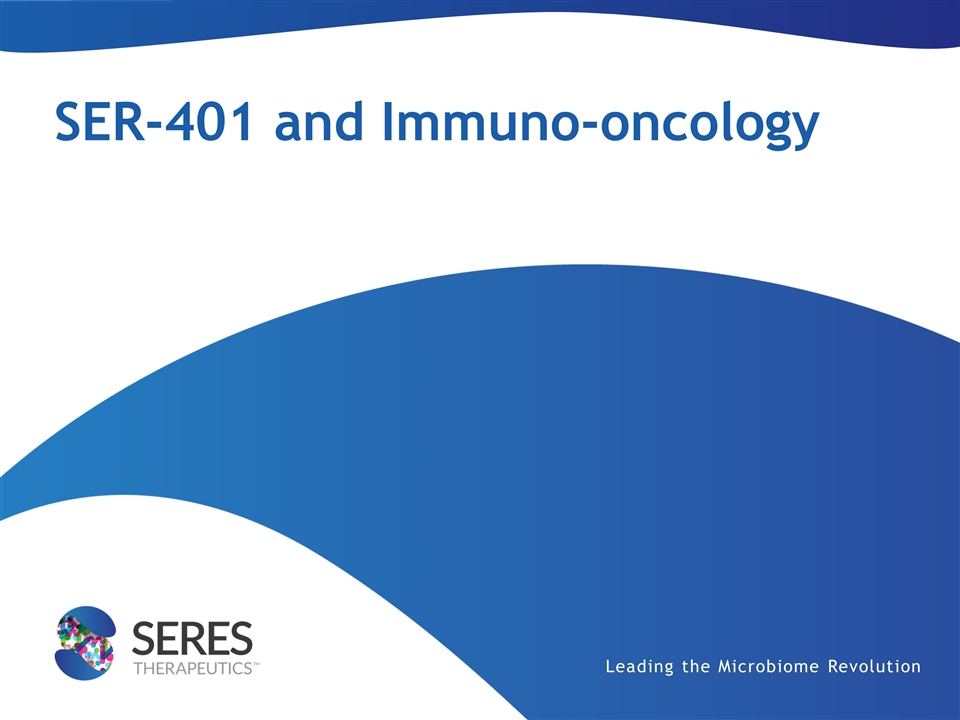
SER-401 and Immuno-oncology
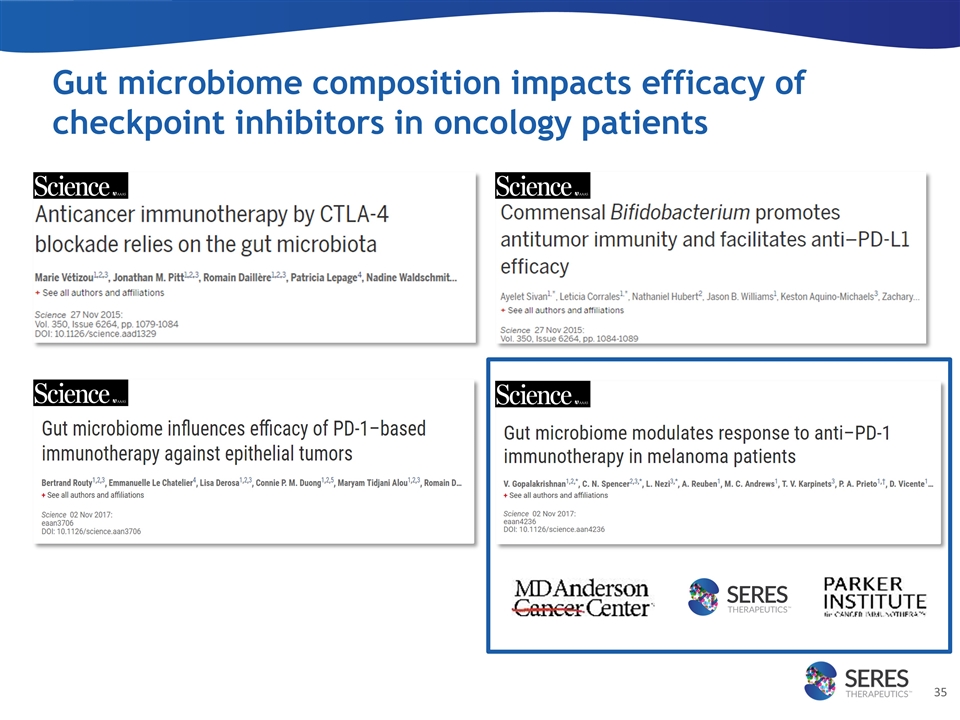
Gut microbiome composition impacts efficacy of checkpoint inhibitors in oncology patients
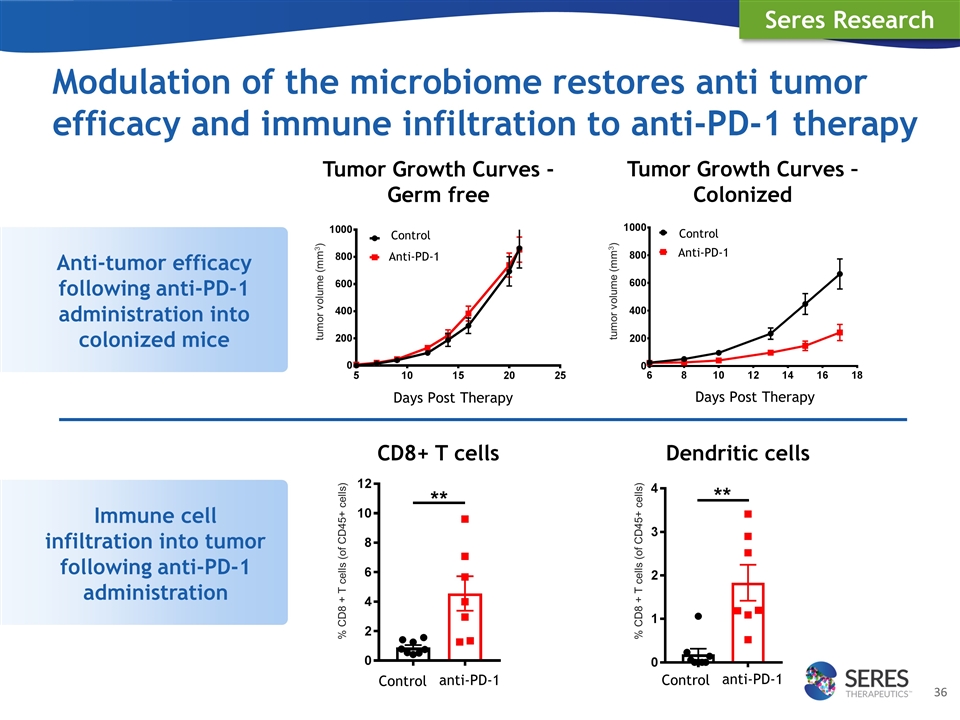
Modulation of the microbiome restores anti tumor efficacy and immune infiltration to anti-PD-1 therapy Immune cell infiltration into tumor following anti-PD-1 administration Dendritic cells CD8+ T cells Seres Research Anti-tumor efficacy following anti-PD-1 administration into colonized mice Tumor Growth Curves – Colonized Days Post Therapy Days Post Therapy Tumor Growth Curves - Germ free anti-PD-1 Control anti-PD-1 Control Control Anti-PD-1 Control Anti-PD-1 tumor volume (mm3) tumor volume (mm3) % CD8 + T cells (of CD45+ cells) % CD8 + T cells (of CD45+ cells)
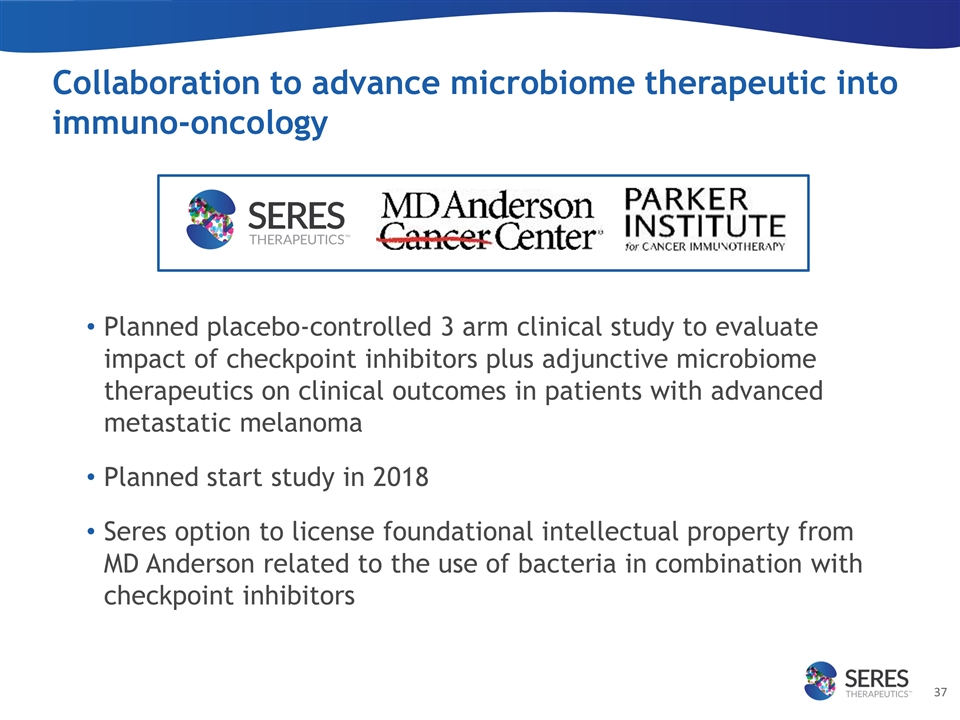
Collaboration to advance microbiome therapeutic into immuno-oncology Planned placebo-controlled 3 arm clinical study to evaluate impact of checkpoint inhibitors plus adjunctive microbiome therapeutics on clinical outcomes in patients with advanced metastatic melanoma Planned start study in 2018 Seres option to license foundational intellectual property from MD Anderson related to the use of bacteria in combination with checkpoint inhibitors
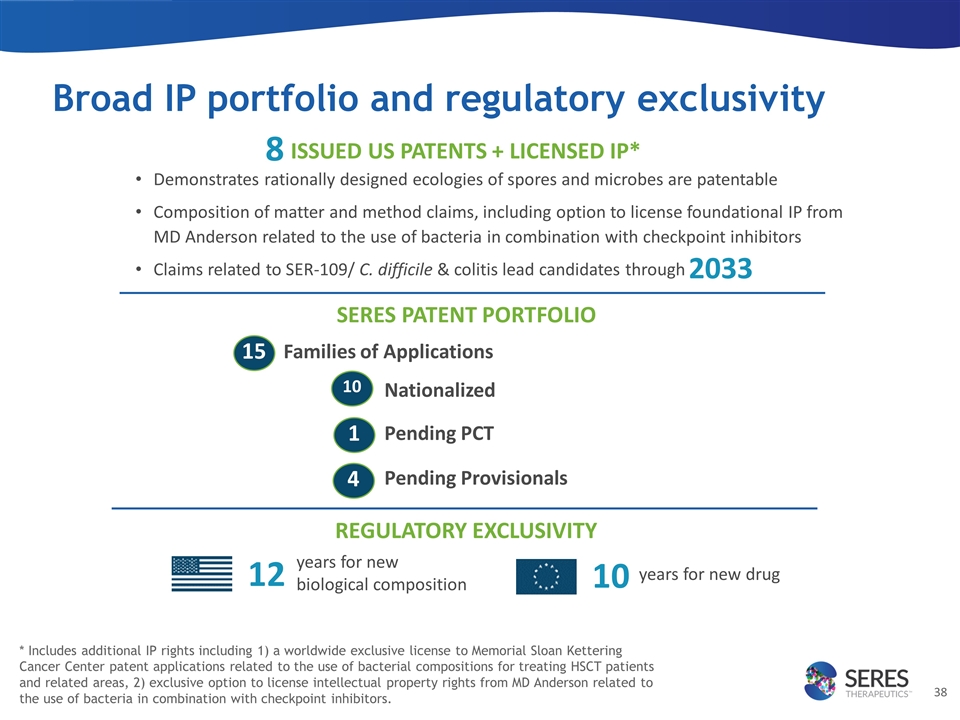
Broad IP portfolio and regulatory exclusivity Families of Applications Nationalized Pending PCT Pending Provisionals SERES PATENT PORTFOLIO 15 10 1 REGULATORY EXCLUSIVITY years for new biological composition 12 years for new drug 10 ISSUED US PATENTS + LICENSED IP* Demonstrates rationally designed ecologies of spores and microbes are patentable Composition of matter and method claims, including option to license foundational IP from MD Anderson related to the use of bacteria in combination with checkpoint inhibitors Claims related to SER-109/ C. difficile & colitis lead candidates through 2033 4 * Includes additional IP rights including 1) a worldwide exclusive license to Memorial Sloan Kettering Cancer Center patent applications related to the use of bacterial compositions for treating HSCT patients and related areas, 2) exclusive option to license intellectual property rights from MD Anderson related to the use of bacteria in combination with checkpoint inhibitors. 8
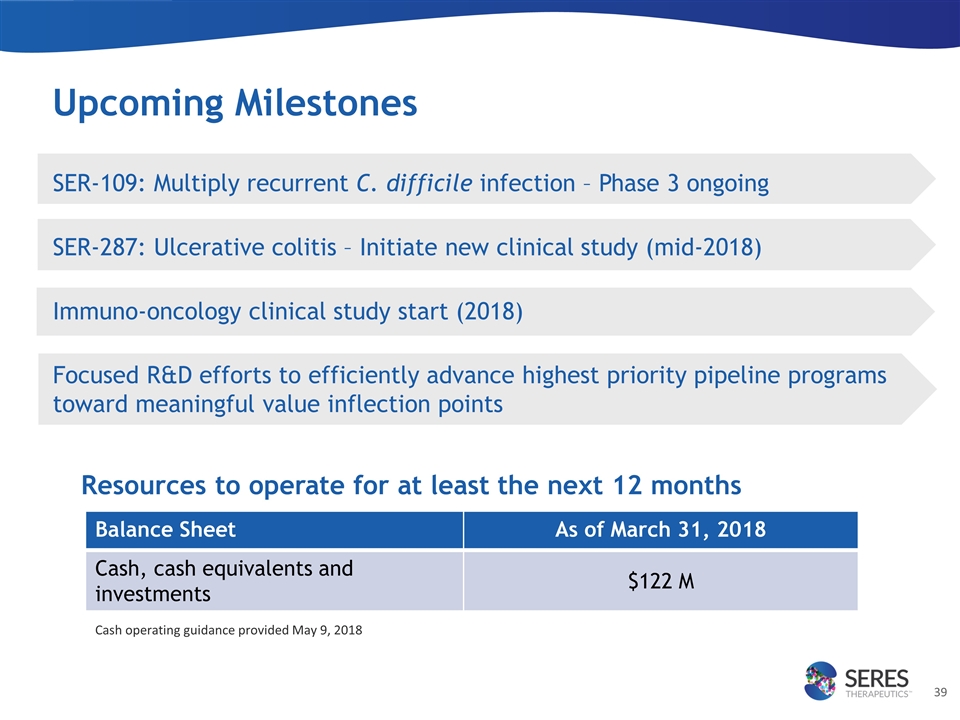
Resources to operate for at least the next 12 months Balance Sheet As of March 31, 2018 Cash, cash equivalents and investments $122 M SER-109: Multiply recurrent C. difficile infection – Phase 3 ongoing SER-287: Ulcerative colitis – Initiate new clinical study (mid-2018) Immuno-oncology clinical study start (2018) Focused R&D efforts to efficiently advance highest priority pipeline programs toward meaningful value inflection points Upcoming Milestones Cash operating guidance provided May 9, 2018
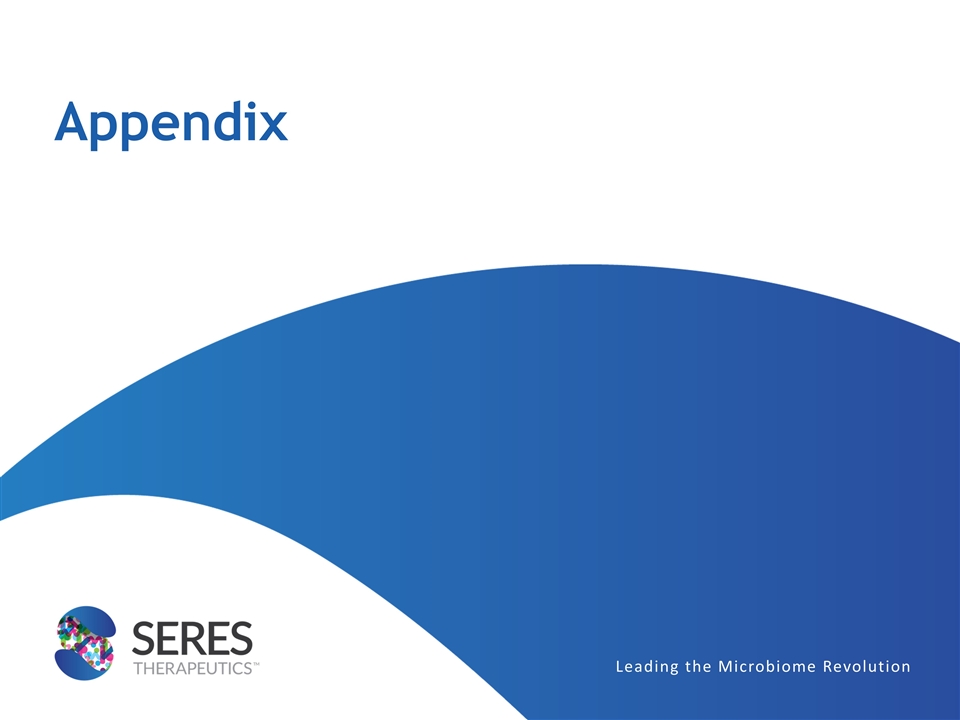
Appendix
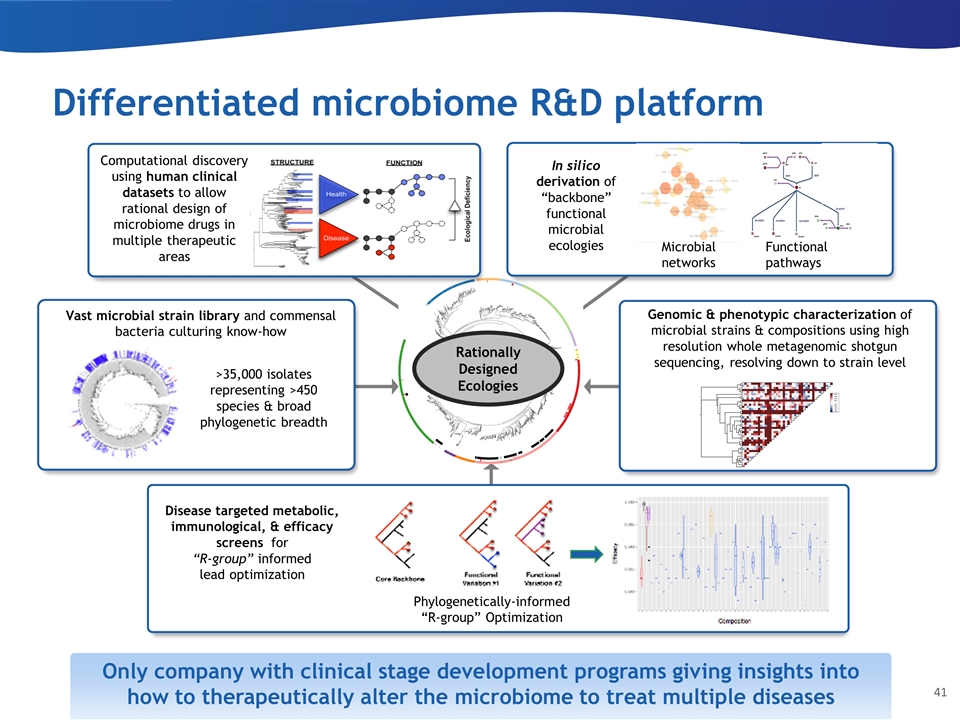
Differentiated microbiome R&D platform Computational discovery using human clinical datasets to allow rational design of microbiome drugs in multiple therapeutic areas Vast microbial strain library and commensal bacteria culturing know-how Disease targeted metabolic, immunological, & efficacy screens for “R-group” informed lead optimization Rationally Designed Ecologies Functional pathways Microbial networks In silico derivation of “backbone” functional microbial ecologies Genomic & phenotypic characterization of microbial strains & compositions using high resolution whole metagenomic shotgun sequencing, resolving down to strain level >35,000 isolates representing >450 species & broad phylogenetic breadth Compositional Variants Efficacy Metric Phylogenetically-informed “R-group” Optimization Only company with clinical stage development programs giving insights into how to therapeutically alter the microbiome to treat multiple diseases
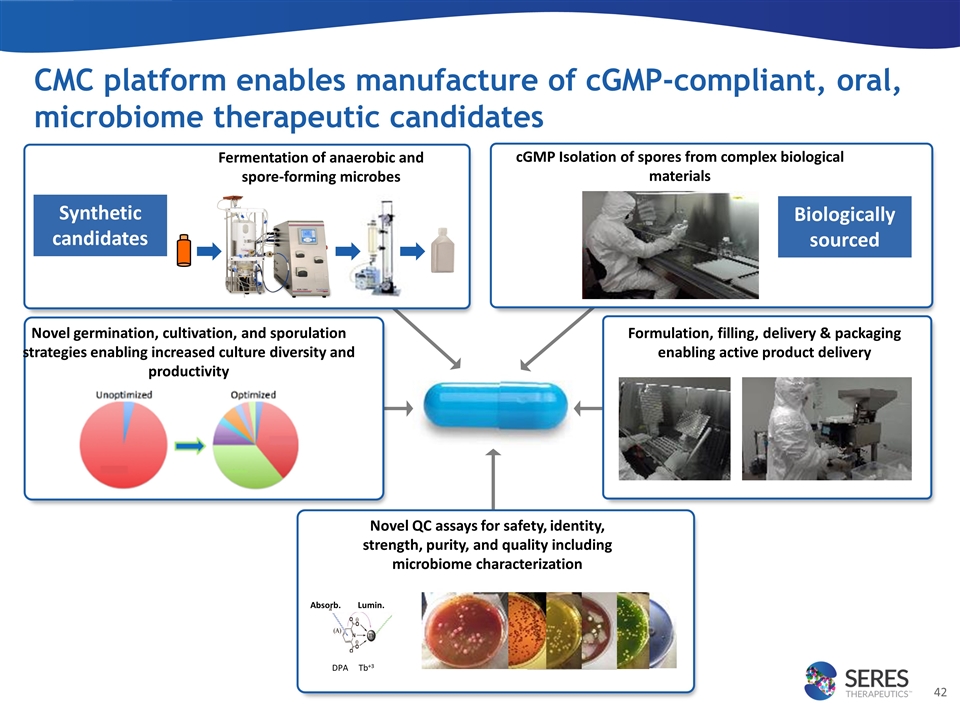
CMC platform enables manufacture of cGMP-compliant, oral, microbiome therapeutic candidates Fermentation of anaerobic and spore-forming microbes Formulation, filling, delivery & packaging enabling active product delivery cGMP Isolation of spores from complex biological materials Synthetic candidates Biologically sourced Novel QC assays for safety, identity, strength, purity, and quality including microbiome characterization Absorb. Lumin. DPA Tb+3 Novel germination, cultivation, and sporulation strategies enabling increased culture diversity and productivity aa
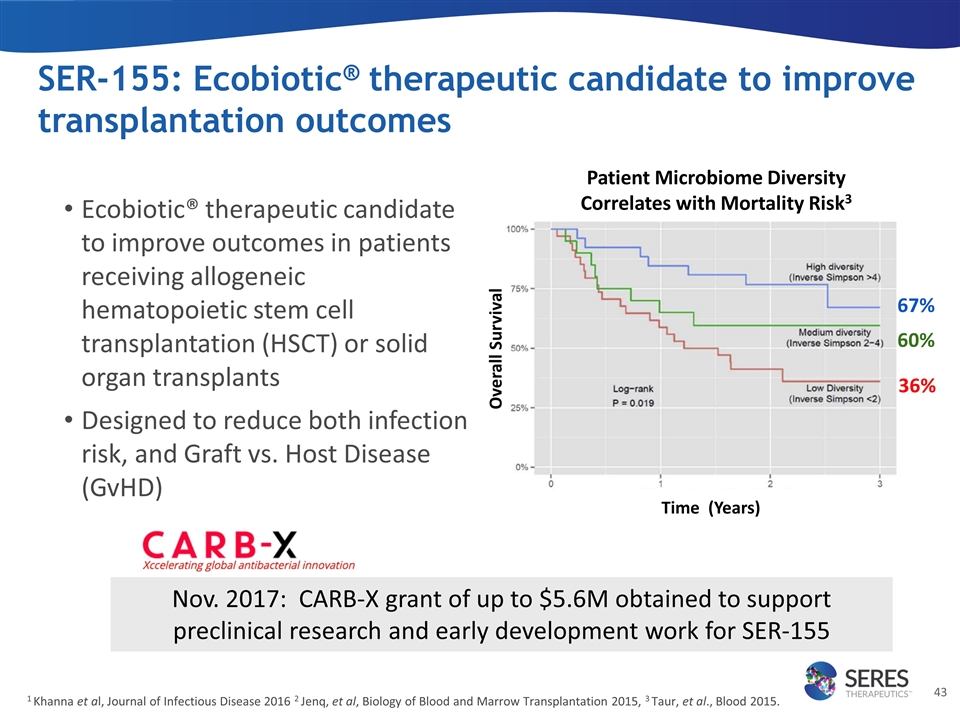
SER-155: Ecobiotic® therapeutic candidate to improve transplantation outcomes 1 Khanna et al, Journal of Infectious Disease 2016 2 Jenq, et al, Biology of Blood and Marrow Transplantation 2015, 3 Taur, et al., Blood 2015. 36% 60% 67% Overall Survival Patient Microbiome Diversity Correlates with Mortality Risk3 Ecobiotic® therapeutic candidate to improve outcomes in patients receiving allogeneic hematopoietic stem cell transplantation (HSCT) or solid organ transplants Designed to reduce both infection risk, and Graft vs. Host Disease (GvHD) Time (Years) Nov. 2017: CARB-X grant of up to $5.6M obtained to support preclinical research and early development work for SER-155










































